Heterocyclic Compound And Organic Light Emitting Device Using Same
LA; Hyun-Ju ; et al.
U.S. patent application number 16/757086 was filed with the patent office on 2020-07-30 for heterocyclic compound and organic light emitting device using same. This patent application is currently assigned to HEESUNG MATERIAL LTD.. The applicant listed for this patent is HEESUNG MATERIAL LTD.. Invention is credited to Dae-Hyuk CHOI, Jin-Seok CHOI, Yu-Jin HEO, Won-Jang JEONG, Hyun-Ju LA, Joo-Dong LEE.
| Application Number | 20200243775 16/757086 |
| Document ID | 20200243775 / US20200243775 |
| Family ID | 1000004777643 |
| Filed Date | 2020-07-30 |
| Patent Application | download [pdf] |
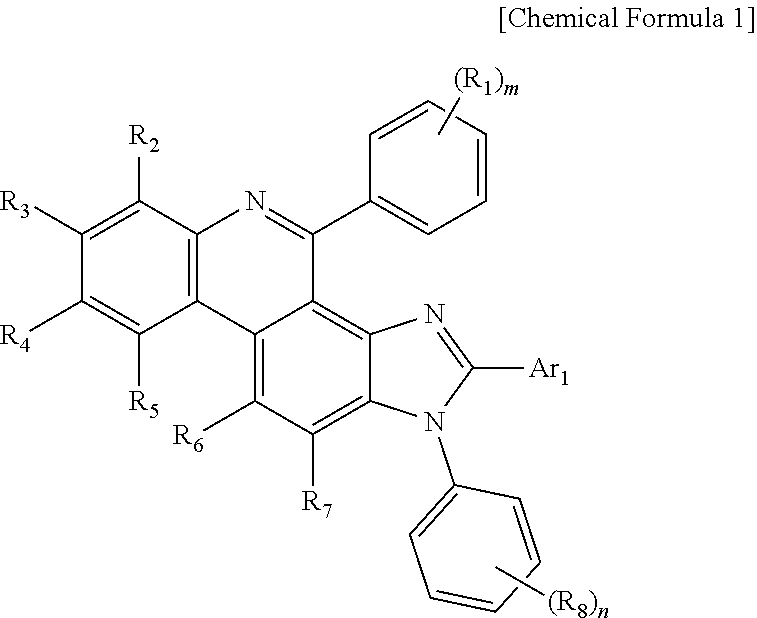
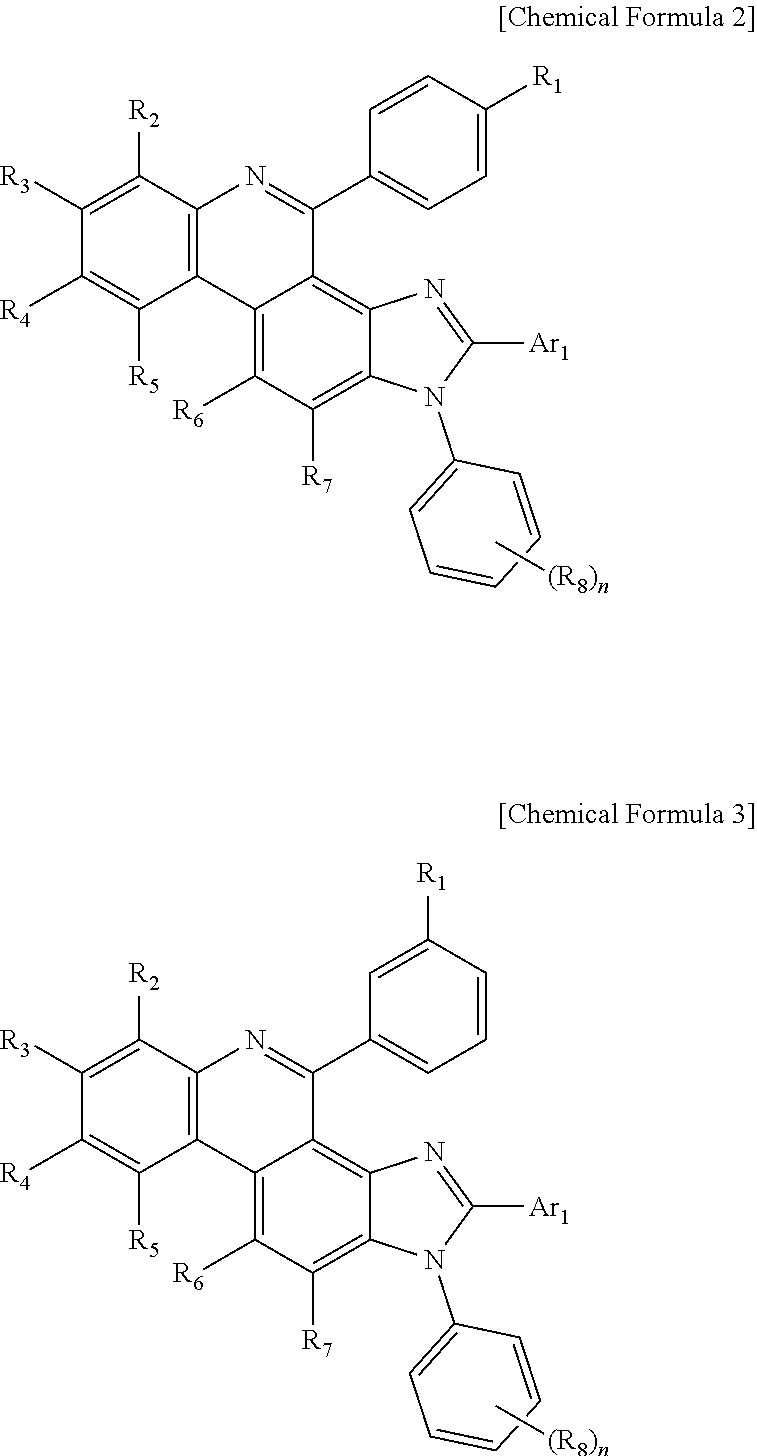
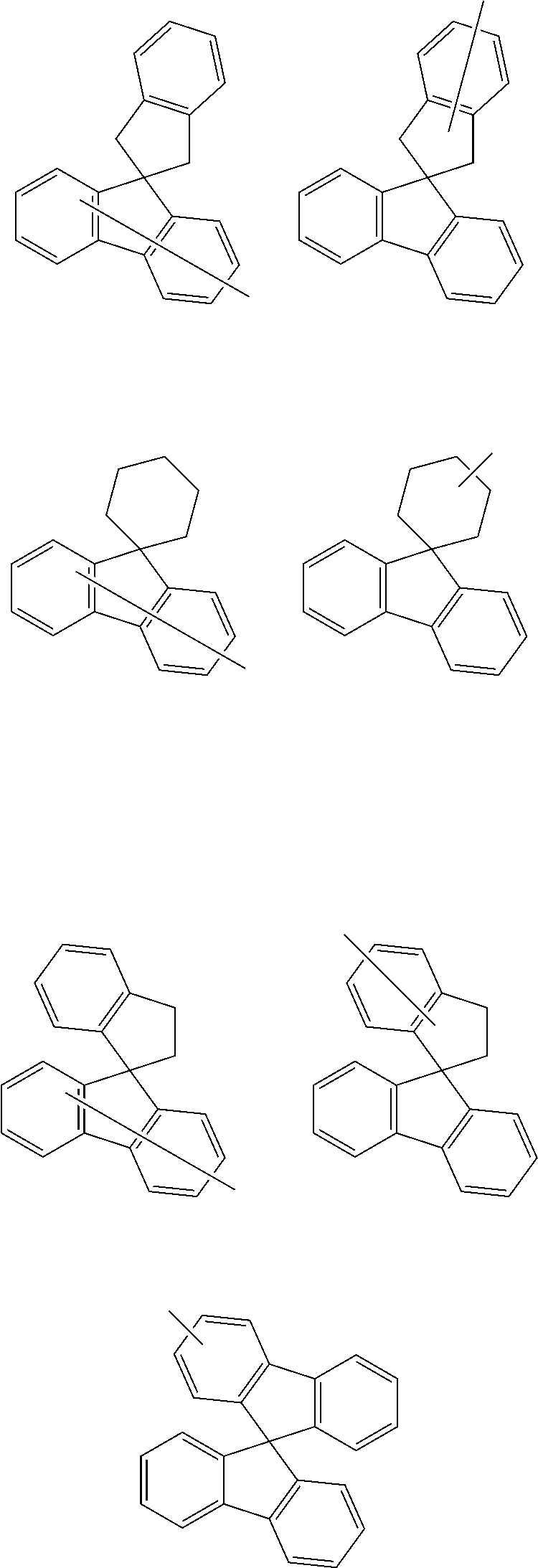









View All Diagrams
| United States Patent Application | 20200243775 |
| Kind Code | A1 |
| LA; Hyun-Ju ; et al. | July 30, 2020 |
HETEROCYCLIC COMPOUND AND ORGANIC LIGHT EMITTING DEVICE USING SAME
Abstract
The present specification relates to a hetero-cyclic compound represented by Chemical Formula 1, and an organic light emitting device comprising the same.
| Inventors: | LA; Hyun-Ju; (Hwaseong-si, KR) ; HEO; Yu-Jin; (Osan-si, KR) ; JEONG; Won-Jang; (Hwaseong-si, KR) ; CHOI; Jin-Seok; (Suwon-si, KR) ; CHOI; Dae-Hyuk; (Yongin-si, KR) ; LEE; Joo-Dong; (Seongnam-si, KR) | ||||||||||
| Applicant: |
|
||||||||||
|---|---|---|---|---|---|---|---|---|---|---|---|
| Assignee: | HEESUNG MATERIAL LTD. Yongin-City, Gyeonggi-do KR |
||||||||||
| Family ID: | 1000004777643 | ||||||||||
| Appl. No.: | 16/757086 | ||||||||||
| Filed: | October 18, 2018 | ||||||||||
| PCT Filed: | October 18, 2018 | ||||||||||
| PCT NO: | PCT/KR2018/012327 | ||||||||||
| 371 Date: | April 17, 2020 |
| Current U.S. Class: | 1/1 |
| Current CPC Class: | C07D 471/04 20130101; H01L 51/5096 20130101; H01L 51/5044 20130101; H01L 51/0072 20130101; H01L 51/5092 20130101; H01L 51/5056 20130101; H01L 51/5088 20130101; H01L 51/5072 20130101 |
| International Class: | H01L 51/00 20060101 H01L051/00; C07D 471/04 20060101 C07D471/04 |
Foreign Application Data
| Date | Code | Application Number |
|---|---|---|
| Oct 19, 2017 | KR | 10-2017-0135673 |
Claims
1. A hetero-cyclic compound represented by the following Chemical Formula 1: ##STR00145## wherein, in Chemical Formula 1, R.sub.1 is hydrogen; a substituted or unsubstituted C.sub.1 to C.sub.60 alkyl group; a substituted or unsubstituted C.sub.6 to C.sub.60 aryl group; a substituted or unsubstituted C.sub.2 to C.sub.60 heteroaryl group; --Si RR'R''; --P(.dbd.O)RR'; or --CN; R.sub.2 to R.sub.8 are the same as or different from each other, and each independently hydrogen; a substituted or unsubstituted C.sub.1 to C.sub.60 alkyl group; a substituted or unsubstituted C.sub.6 to C.sub.60 aryl group; a substituted or unsubstituted C.sub.2 to C.sub.60 heteroaryl group; --SiRR'R''; --P(.dbd.O)RR'; and an amine group unsubstituted or substituted with a C.sub.1 to C.sub.20 alkyl group, a C.sub.6 to C.sub.60 ary group or a C.sub.2 to C.sub.60 heteroaryl group; Ar.sub.1 is a substituted or unsubstituted C.sub.1 to C.sub.60 alkyl group; m and n are each independently an integer of 0 to 5; and R, R' and R'' are the same as or different from each other, and each independently hydrogen; deuterium; --CN; a substituted or unsubstituted C.sub.1 to C.sub.60 alkyl group; a substituted or unsubstituted C.sub.3 to C.sub.60 cycloalkyl group; a substituted or unsubstituted C.sub.6 to C.sub.60 aryl group; or a substituted or unsubstituted C7 to C.sub.60 heteroaryl group.
2. The hetero-cyclic compound of claim 1, wherein the "substituted or unsubstituted" means being substituted with one or more substituents selected from the group consisting of C.sub.1 to C.sub.60 linear or branched alkyl; C.sub.2 to C.sub.60 linear or branched alkenyl; C.sub.2 to C.sub.60 linear or branched alkynyl; C.sub.3 to C.sub.60 monocyclic or polycyclic cycloalkyl; C.sub.2 to C.sub.60 monocyclic or polycyclic heterocycloalkyl; C.sub.6 to C.sub.60 monocyclic or polycyclic aryl; C.sub.2 to C.sub.60 monocyclic or polycyclic heteroaryl; --SiRR'R''; --P(.dbd.O)RR'; C.sub.1 to C.sub.20 alkylamine; C.sub.6 to C60 monocyclic or polycyclic arylamine; and C.sub.2 to C.sub.60 monocyclic or polycyclic heteroarylamine, or being unsubstituted, or being substituted with a substituent linking two or more substituents selected from among the substituents illustrated above, or being unsubstituted.
3. The hetero-cyclic compound of claim 1, wherein R.sub.1 of Chemical Formula 1 is represented by -(L).sub.p-(Z).sub.q; L is a direct bond; a substituted or unsubstituted C.sub.6 to C.sub.60 arylene group; or a substituted or unsubstituted C.sub.2 to C.sub.60 heteroarylene group; Z is hydrogen; a substituted or unsubstituted C.sub.1 to C.sub.60 alkyl group; a substituted or unsubstituted C.sub.6 to C.sub.60 aryl group: a substituted or unsubstituted C.sub.2 to C.sub.60 heteroaryl group; --CN; --SiRR'R''; or --P(.dbd.O)RR'; R, R' and R'' are the same as or different from each other, and each independently hydrogen; deuterium; --CN; a substituted or unsubstituted C.sub.1 to C.sub.60 alkyl group; a substituted or unsubstituted C.sub.3 to C.sub.60 cycloalkyl group; a substituted or unsubstituted. C.sub.6 to C.sub.60 aryl group; or a substituted or unsubstituted C.sub.2 to C.sub.60 heteroaryl group; and p and q are an integer of 1 to 4.
4. The hetero-cyclic compound of claim 1, wherein Ar.sub.1 is an ethyl group.
5. The hetero-cyclic compound of claim 1, wherein Chemical Formula 1 is represented by the following Chemical Formula 2 or 3: ##STR00146## in Chemical Formulae 2 and 3, Ar.sub.1, R.sub.1 to R.sub.8 and n have the same definitions as in Chemical Formula 1.
6. The hetero-cyclic compound of claim 1, wherein Chemical Formula 1 is represented by any one of the following compounds: ##STR00147## ##STR00148## ##STR00149## ##STR00150## ##STR00151## ##STR00152## ##STR00153## ##STR00154## ##STR00155## ##STR00156## ##STR00157## ##STR00158## ##STR00159## ##STR00160## ##STR00161## ##STR00162## ##STR00163## ##STR00164## ##STR00165## ##STR00166## ##STR00167## ##STR00168## ##STR00169## ##STR00170## ##STR00171## ##STR00172## ##STR00173## ##STR00174## ##STR00175## ##STR00176## ##STR00177## ##STR00178## ##STR00179## ##STR00180## ##STR00181## ##STR00182## ##STR00183## ##STR00184## ##STR00185## ##STR00186## ##STR00187## ##STR00188## ##STR00189## ##STR00190## ##STR00191## ##STR00192## ##STR00193## ##STR00194## ##STR00195## ##STR00196## ##STR00197## ##STR00198## ##STR00199## ##STR00200## ##STR00201## ##STR00202## ##STR00203## ##STR00204##
7. An organic light emitting device comprising: a first electrode; a second electrode provided opposite to the first electrode; and one or more organic material layers provided between the first electrode and the second electrode, wherein one or more layers of the organic material layers comprise the hetero-cyclic compound of claim 1.
8. The organic light emitting device of claim 7, wherein the organic material layer comprises an electron transfer layer, and the electron transfer layer comprises the hetero-cyclic compound.
9. The organic light emitting device of claim 7, wherein the organic material layer comprises an electron blocking layer or a hole blocking layer, and the electron blocking layer or the hole blocking layer comprises the hetero-cyclic compound.
10. The organic tight emitting device of claim 7, further comprising one, two or more layers selected from the group consisting of a light emitting layer, a hole injection layer, a hole transfer layer. an electron injection layer, an electron transfer layer, an electron blocking layer and a hole blocking layer.
7. The organic light emitting device of claim 7, wherein the organic material layer comprises a charge generation layer, and the charge generation layer comprises the hetero-cyclic compound.
12. The organic light emitting device of claim 7, comprising: a first electrode; a first stack provided on the first electrode and comprising a first light emitting layer; a charge generation layer provided on the first stack; a second stack provided on the charge generation layer and comprising a second light emitting layer; and a second electrode provided on the second stack.
13. The organic light emitting device of claim 12, wherein the charge generation layer comprises the hetero-cyclic compound represented by Chemical Formula 1.
Description
TECHNICAL FIELD
[0001] This application claims priority to and the benefits of Korean Patent Application No. 10-2017-0135673, filed with the Korean Intellectual Property Office on Oct. 19, 2017, the entire contents of which are incorporated herein by reference.
[0002] The present application relates to a hetero-cyclic compound and an organic light emitting device using the same.
BACKGROUND ART
[0003] An electroluminescent device is one type of self-emissive display devices, and has an advantage of having a wide viewing angle, and a high response speed as well as having an excellent contrast.
[0004] An organic light emitting device has a structure disposing an organic thin film between two electrodes. When a voltage is applied to an organic light emitting device having such a structure, electrons and holes injected from the two electrodes bind and pair in the organic thin film, and light emits as these annihilate. The organic thin film may be formed in a single layer or a multilayer as necessary.
[0005] A material of the organic thin film may have a light emitting function as necessary. For example, as a material of the organic thin film, compounds capable of forming a light emitting layer themselves alone may be used, or compounds capable of performing a role of a host or a dopant of a host-dopant-based light emitting layer may also be used. In addition thereto, compounds capable of performing roles of hole injection, hole transfer, electron blocking, hole blocking, electron transfer, electron injection and the like may also be used as a material of the organic thin film.
[0006] Development of an organic thin film material has been continuously required for enhancing performance, lifetime or efficiency of an organic light emitting device.
DISCLOSURE
Technical Problem
[0007] The present application is directed to providing a novel hetero-cyclic compound and an organic light emitting device using the same.
Technical Solution
[0008] One embodiment of the present application provides a hetero-cyclic compound represented by the following Chemical Formula 1.
##STR00001##
[0009] In Chemical Formula 1,
[0010] R.sub.1 is hydrogen; a substituted or unsubstituted C.sub.1 to C.sub.60 alkyl group; a substituted or unsubstituted C.sub.6 to C.sub.60 aryl group; a substituted or unsubstituted C.sub.2 to C.sub.60 heteroaryl group; --SiRR'R''; --P(.dbd.O)RR'; or --CN,
[0011] R.sub.2 to R.sub.8 are the same as or different from each other, and each independently selected from the group consisting of hydrogen; a substituted or unsubstituted C.sub.1 to C.sub.60 alkyl group; a substituted or unsubstituted C.sub.6 to C.sub.60 aryl group; a substituted or unsubstituted C.sub.2 to C.sub.60 heteroaryl group; --SiRR'R''; --P(.dbd.O)RR'; and an amine group unsubstituted or substituted with a C.sub.1 to C.sub.20 alkyl group, a C.sub.6 to C.sub.60 aryl group or a C.sub.2 to C.sub.60 heteroaryl group, Ar.sub.1 is a substituted or unsubstituted C.sub.1 to C.sub.60 alkyl group,
[0012] m and n are each independently an integer of 0 to 5,
[0013] R, R' and R'' are the same as or different from each other, and each independently hydrogen; deuterium; --CN; a substituted or unsubstituted C.sub.1 to C.sub.60 alkyl group; a substituted or unsubstituted C.sub.3 to C.sub.60 cycloalkyl group; a substituted or unsubstituted C.sub.6 to C.sub.60 aryl group; or a substituted or unsubstituted C.sub.2 to C.sub.60 heteroaryl group.
[0014] Another embodiment of the present application provides an organic light emitting device comprising a first electrode, a second electrode, and one or more organic material layers provided between the first electrode and the second electrode, wherein one or more layers of the organic material layers comprise the hetero-cyclic compound.
Advantageous Effects
[0015] The hetero-cyclic compound according to one embodiment of the present application can be used as an organic material layer material of an organic light emitting device. The hetero-cyclic compound can be used as a material of a hole injection layer, a hole transfer layer, a light emitting layer, an electron transfer layer, an electron injection layer, a charge generation layer or the like in an organic light emitting device. Particularly, the hetero-cyclic compound represented by Chemical Formula 1 can be used as a material of an electron transfer layer or a charge generation layer in an organic light emitting device. In addition, using the hetero-cyclic compound represented by Chemical Formula 1 in an organic light emitting device lowers a driving voltage of the device, enhances light efficiency, and can enhance lifetime properties of the device with thermal stability of the compound.
Description of Drawings
[0016] FIG. 1 to FIG. 4 are diagrams each schematically illustrating a lamination structure of an organic light emitting device according to one embodiment of the present application.
REFERENCE NUMERAL
[0017] 100: Substrate
[0018] 200: Anode
[0019] 300: Organic Material Layer
[0020] 301: Hole Injection Layer
[0021] 302: Hole Transfer Layer
[0022] 303: Light Emitting Layer
[0023] 304: Hole Blocking Layer
[0024] 305: Electron Transfer Layer
[0025] 306: Electron Injection Layer
[0026] 400: Cathode
MODE FOR DISCLOSURE
[0027] Hereinafter, the present application will be described in detail.
[0028] A hetero-cyclic compound according to one embodiment of the present application is represented by Chemical Formula 1. More specifically, due to structural properties of a core structure and substituents as above, a hetero-cyclic compound represented by Chemical Formula 1 may be used as an organic material layer material of an organic light emitting device.
[0029] In one embodiment of the present application, when m of Chemical Formula 1 is 2 or greater, two or more R.sub.1s may be the same as or different from each other. In addition, when n of Chemical Formula 1 is 2 or greater, two or more R.sub.8s may be the same as or different from each other.
[0030] In one embodiment of the present application, R.sub.1 of Chemical Formula 1 may be hydrogen; a substituted or unsubstituted C.sub.1 to C.sub.60 alkyl group; a substituted or unsubstituted C.sub.6 to C.sub.60 aryl group; a substituted or unsubstituted C.sub.2 to C.sub.60 heteroaryl group; --SiRR'R''; --P(.dbd.O)RR'; or --CN.
[0031] In another embodiment, R.sub.1 of Chemical Formula 1 may be hydrogen; a substituted or unsubstituted C.sub.1 to C.sub.40 alkyl group; a substituted or unsubstituted C.sub.6 to C.sub.40 aryl group; a substituted or unsubstituted C.sub.2 to C.sub.40 heteroaryl group; --SiRR'R''; --P(.dbd.O)RR'; or --CN.
[0032] In one embodiment of the present application, R.sub.2 to R.sub.8 of Chemical Formula 1 are the same as or different from each other, and may be each independently selected form the group consisting of hydrogen; a substituted or unsubstituted C.sub.1 to C.sub.60 alkyl group; a substituted or unsubstituted C.sub.6 to C.sub.60 aryl group; a substituted or unsubstituted C.sub.2 to C.sub.60 heteroaryl group; --SiRR'R''; --P(.dbd.O)RR'; and an amine group unsubstituted or substituted with a C.sub.1 to C.sub.20 alkyl group, a C.sub.6 to C.sub.60 aryl group or a C.sub.2 to C.sub.60 heteroaryl group.
[0033] In another embodiment, R.sub.2 to R.sub.8 of Chemical Formula 1 are the same as or different from each other, and may be each independently hydrogen; a substituted or unsubstituted C.sub.6 to C.sub.40 aryl group; a substituted or unsubstituted C.sub.2 to C.sub.40 heteroaryl group.
[0034] In another embodiment, R.sub.2 to R.sub.8 of Chemical Formula 1 may be hydrogen.
[0035] In one embodiment of the present application, Ar.sub.1 of Chemical Formula 1 may be a substituted or unsubstituted C.sub.1 to C60 alkyl group.
[0036] In another embodiment, Ar.sub.1 of Chemical Formula 1 may be a substituted or unsubstituted C.sub.1 to C.sub.40 alkyl group.
[0037] In another embodiment, Ar.sub.1 of Chemical Formula 1 may be a C.sub.1 to C.sub.40 alkyl group.
[0038] In another embodiment, Ar.sub.1 of Chemical Formula 1 may be selected from the group consisting of a methyl group; an ethyl group; a propyl group; or a butyl group.
[0039] In another embodiment, Ar.sub.1 of Chemical Formula 1 may be an ethyl group.
[0040] In one embodiment of the present application, R.sub.1 of Chemical Formula 1 may be represented by -(L).sub.p-(Z).sub.q,
[0041] L is a direct bond; a substituted or unsubstituted C.sub.6 to C.sub.60 arylene group; or a substituted or unsubstituted C.sub.2 to C.sub.60 heteroarylene group,
[0042] Z is hydrogen; a substituted or unsubstituted C.sub.1 to C.sub.60 alkyl group; a substituted or unsubstituted C.sub.6 to C.sub.60 aryl group; a substituted or unsubstituted C.sub.2 to C.sub.60 heteroaryl group; --CN; --SiRR'R''; or --P(.dbd.O)RR',
[0043] R, R' and R'' are the same as or different from each other, and each independently hydrogen; deuterium; --CN; a substituted or unsubstituted C.sub.1 to C.sub.60 alkyl group; a substituted or unsubstituted C.sub.3 to C.sub.60 cycloalkyl group; a substituted or unsubstituted C.sub.6 to C.sub.60 aryl group; or a substituted or unsubstituted C.sub.2 to C.sub.60 heteroaryl group, and
[0044] p and q are an integer of 1 to 4.
[0045] In one embodiment of the present application, L may be a direct bond; a substituted or unsubstituted C.sub.6 to C.sub.40 arylene group; or a substituted or unsubstituted C.sub.2 to C.sub.40 heteroarylene group.
[0046] In another embodiment, L may be a direct bond; a C.sub.6 to C.sub.40 arylene group; or a C.sub.2 to C.sub.40 heteroarylene group.
[0047] In another embodiment, L may be a direct bond; a C.sub.6 to C.sub.40 monocyclic or polycyclic arylene group; or a C.sub.2 to C.sub.40 monocyclic or polycyclic heteroarylene group.
[0048] In another embodiment, L may be a direct bond; a C.sub.6 to C.sub.40 monocyclic or polycyclic arylene group; or a C.sub.2 to C.sub.40 monocyclic or polycyclic N-containing heteroarylene group.
[0049] In another embodiment, L may be a direct bond; a phenylene group; a naphthalene group; an anthracenylene group; a divalent pyridine group; a divalent pyrimidine group; a divalent triazine group; or a divalent quinazoline group.
[0050] In one embodiment of the present application, Z may be hydrogen; a substituted or unsubstituted C.sub.1 to C.sub.60 alkyl group; a substituted or unsubstituted C.sub.6 to C.sub.60 aryl group; a substituted or unsubstituted C.sub.2 to C.sub.60 heteroaryl group; --CN; --SiRR'R''; or --P(.dbd.O)RR'.
[0051] In another embodiment, Z may be hydrogen; a substituted or unsubstituted C.sub.6 to C.sub.40 aryl group; a substituted or unsubstituted C.sub.2 to C.sub.60 heteroaryl group; --CN; or --P(.dbd.O)RR'.
[0052] In another embodiment, Z may be hydrogen; a substituted or unsubstituted C.sub.6 to C.sub.40 monocyclic or polycyclic aryl group; a substituted or unsubstituted C.sub.2 to C.sub.60 monocyclic or polycyclic heteroaryl group; --CN; or --P(.dbd.O)RR'.
[0053] In another embodiment, Z may be hydrogen; a C.sub.6 to C.sub.40 monocyclic or polycyclic aryl group unsubstituted or substituted with one or more substituents selected from the group consisting of a C.sub.6 to C.sub.40 aryl group, a C.sub.2 to C.sub.40 heteroaryl group and --CN; a C.sub.2 to C.sub.60 monocyclic or polycyclic heteroaryl group unsubstituted or substituted with one or more substituents selected from the group consisting of a C.sub.1 to C.sub.40 alkyl group, a C.sub.6 to C.sub.40 aryl group and a C.sub.2 to C.sub.40 heteroaryl group; --CN; or --P(.dbd.O)RR'.
[0054] In another embodiment, Z may be hydrogen; P(.dbd.O)RR'; or --CN.
[0055] In another embodiment, Z may be a phenyl group unsubstituted or substituted with one or more substituents selected from the group consisting of a phenyl group, a carbazole group and --CN; a biphenyl group; a naphthyl group; a phenanthrene group; or a triphenylene group.
[0056] In another embodiment, Z may be a pyridine group unsubstituted or substituted with one or more substituents selected from the group consisting of a phenyl group and a pyridine group; a pyrimidine group unsubstituted or substituted with one or more substituents selected from the group consisting of a phenyl group, a biphenyl group, a naphthyl group and a pyridine group; a triazine group unsubstituted or substituted with one or more substituents selected from the group consisting of a phenyl group, a biphenyl group, a naphthyl group and a pyridine group; a quinazoline group unsubstituted or substituted with one or more substituents selected from the group consisting of a phenyl group, a biphenyl group and a naphthyl group; a carbazole group; a phenanthroline group unsubstituted or substituted with a phenyl group; a quinoline group; a 1,5-naphthyridyl group; a benzimidazole group unsubstituted or substituted with a methyl group, an ethyl group or a phenyl group; a benzothiazole group unsubstituted or substituted with a phenyl group; a 1,3,4-oxadiazole group unsubstituted or substituted with a phenyl group; an imidazo[1,2-a]pyridine group unsubstituted or substituted with a phenyl group; a pyrido[1,2-b]indazole group; or a pyrazolo[1,5-c]quinazolinyl group unsubstituted or substituted with a phenyl group.
[0057] In one embodiment of the present application, R, R' and R'' are the same as or different from each other, and may be each independently hydrogen; deuterium; --CN; a substituted or unsubstituted C.sub.1 to C.sub.60 alkyl group; a substituted or unsubstituted C.sub.3 to C.sub.60 cycloalkyl group; a substituted or unsubstituted C.sub.6 to C.sub.60 aryl group; or a substituted or unsubstituted C.sub.2 to C.sub.60 heteroaryl group.
[0058] In another embodiment, R, R' and R'' are the same as or different from each other, and may be each independently hydrogen; a substituted or unsubstituted C.sub.6 to C.sub.40 aryl group; or a substituted or unsubstituted C.sub.2 to C.sub.40 heteroaryl group.
[0059] In another embodiment, R, R' and R'' are the same as or different from each other, and may be each independently hydrogen; a C.sub.6 to C.sub.60 aryl group; or a C.sub.2 to C.sub.60 heteroaryl group.
[0060] In another embodiment, R, R' and R'' are the same as or different from each other, and may be each independently a C.sub.6 to C.sub.60 aryl group.
[0061] In another embodiment, R, R' and R'' are the same as or different from each other, and may be each independently a phenyl group.
[0062] In one embodiment of the present application, m may be 1.
[0063] In one embodiment of the present application, m may be 2.
[0064] In one embodiment of the present application, n may be 1.
[0065] In one embodiment of the present application, n may be 2.
[0066] In the hetero-cyclic compound provided in one embodiment of the present application, Chemical Formula 1 is represented by the following Chemical Formula 2 or 3.
##STR00002##
[0067] In Chemical Formulae 2 and 3,
[0068] Ar.sub.1, R.sub.1 to R.sub.8 and n have the same definitions as in
[0069] Chemical Formula 1.
[0070] In the present specification, "substituted or unsubstituted" means being substituted with one or more substituents selected from the group consisting of deuterium; a halogen group; --CN; a C.sub.1 to C.sub.60 alkyl group; a C.sub.2 to C.sub.60 alkenyl group; a C.sub.2 to C.sub.60 alkynyl group; a C.sub.3 to C.sub.60 cycloalkyl group; a C.sub.2 to C.sub.60 heterocycloalkyl group; a C.sub.6 to C.sub.60 aryl group; a C.sub.2 to C.sub.60 heteroaryl group; --SiRR'R''; --P(.dbd.O)RR'; a C.sub.1 to C.sub.20 alkylamine group; a C.sub.6 to C.sub.60 arylamine group; and a C.sub.2 to C.sub.60 heteroarylamine group, or being unsubstituted, or being substituted with a substituent bonding two or more of the substituents illustrated above, or being unsubstituted, or being substituted with a substituent linking two or more substituents selected from among the substituents illustrated above, or being unsubstituted. For example, the "substituent linking two or more substituents" may be a biphenyl group. In other words, a biphenyl group may be an aryl group, or interpreted as a substituent linking two phenyl groups. The additional substituents may be further substituted. R, R' and R'' are the same as or different from each other, and each independently hydrogen; deuterium; --CN; a substituted or unsubstituted C.sub.1 to C.sub.60 alkyl group; a substituted or unsubstituted C.sub.3 to C.sub.60 cycloalkyl group; a substituted or unsubstituted C.sub.6 to C.sub.60 aryl group; or a substituted or unsubstituted C.sub.2 to C.sub.60 heteroaryl group.
[0071] According to one embodiment of the present application, the "substituted or unsubstituted" means being substituted with one or more substituents selected from the group consisting of deuterium, a halogen group, --CN, SiRR'R'', P(.dbd.O)RR', a C.sub.1 to C.sub.20 linear or branched alkyl group, a C.sub.6 to C.sub.60 aryl group and a C.sub.2 to C.sub.60 heteroaryl group, or being unsubstituted, and
[0072] R, R' and R'' are the same as or different from each other, and each independently hydrogen; deuterium; --CN; a C.sub.1 to C60 alkyl group unsubstituted or substituted with deuterium, a halogen group, --CN, a C.sub.1 to C.sub.20 alkyl group, a C.sub.6 to C.sub.60 aryl group and a C.sub.2 to C.sub.60 heteroaryl group; a C.sub.3 to C.sub.60 cycloalkyl group unsubstituted or substituted with deuterium, halogen, --CN, a C.sub.1 to C.sub.20 alkyl group, a C.sub.6 to C.sub.60 aryl group and a C.sub.2 to C.sub.60 heteroaryl group; a C.sub.6 to C.sub.60 aryl group unsubstituted or substituted with deuterium, halogen, --CN, a C.sub.1 to C.sub.20 alkyl group, a C.sub.6 to C.sub.60 aryl group and a C.sub.2 to C.sub.60 heteroaryl group; or a C.sub.2 to C.sub.60 heteroaryl group unsubstituted or substituted with deuterium, halogen, --CN, a C.sub.1 to C.sub.20 alkyl group, a C.sub.6 to C.sub.60 aryl group and a C.sub.2 to C.sub.60 heteroaryl group.
[0073] Particularly, compounds having R.sub.1 substituting at a meta position or a para position of the phenyl group as in Chemical Formula 2 or Chemical Formula 3 have smooth electron migration between molecules due to smooth interactions between the molecules when used as an electron transfer layer material of an organic light emitting device afterword.
[0074] When R.sub.1 of Chemical Formula 1 substitutes at an ortho position of the phenyl group, the molecular size increases compared to the compound having R.sub.1 substituting at a meta position or a para position of the phenyl group as in Chemical Formula 2 or Chemical Formula 3, and the degree of electron migration decreases due to reduced molecular interactions.
[0075] The term "substituted" means a hydrogen atom bonding to a carbon atom of a compound is changed to another substituent, and the position of substitution is not limited as long as it is a position at which the hydrogen atom is substituted, that is, a position at which a substituent can substitute, and when two or more substituents substitute, the two or more substituents may be the same as or different from each other.
[0076] In the present specification, the halogen may be fluorine, chlorine, bromine or iodine.
[0077] In the present specification, the alkyl group comprises linear or branched having 1 to 60 carbon atoms, and may be further substituted with other substituents. The number of carbon atoms of the alkyl group may be from 1 to 60, specifically from 1 to 40 and more specifically from 1 to 20. Specific examples thereof may comprise a methyl group, an ethyl group, a propyl group, an n-propyl group, an isopropyl group, a butyl group, an n-butyl group, an isobutyl group, a tert-butyl group, a sec-butyl group, a 1-methyl-butyl group, a 1-ethyl-butyl group, a pentyl group, an n-pentyl group, an isopentyl group, a neopentyl group, a tert-pentyl group, a hexyl group, an n-hexyl group, a 1-methylpentyl group, a 2-methylpentyl group, a 4-methyl-2-pentyl group, a 3,3-dimethylbutyl group, a 2-ethylbutyl group, a heptyl group, an n-heptyl group, a 1-methylhexyl group, a cyclopentylmethyl group, a cyclohexylmethyl group, an octyl group, an n-octyl group, a tert-octyl group, a 1-methylheptyl group, a 2-ethylhexyl group, a 2-propylpentyl group, an n-nonyl group, a 2,2-dimethylheptyl group, a 1-ethyl-propyl group, a 1,1-dimethyl-propyl group, an isohexyl group, a 2-methylpentyl group, a 4-methylhexyl group, a 5-methylhexyl group and the like, but are not limited thereto.
[0078] In the present specification, the alkenyl group comprises linear or branched having 2 to 60 carbon atoms, and may be further substituted with other substituents. The number of carbon atoms of the alkenyl group may be from 2 to 60, specifically from 2 to 40 and more specifically from 2 to 20. Specific examples thereof may comprise a vinyl group, a 1-propenyl group, an isopropenyl group, a 1-butenyl group, a 2-butenyl group, a 3-butenyl group, a 1-pentenyl group, a 2-pentenyl group, a 3-pentenyl group, a 3-methyl-1-butenyl group, a 1,3-butadienyl group, an allyl group, a 1-phenylvinyl-1-yl group, a 2-phenylvinyl-1-yl group, a 2,2-diphenylvinyl-1-yl group, a 2-phenyl-2-(naphthyl-1-yl)vinyl-1-yl group, a 2,2-bis(diphenyl-1-yl)vinyl-1-yl group, a stilbenyl group, a styrenyl group and the like, but are not limited thereto.
[0079] In the present specification, the alkynyl group comprises linear or branched having 2 to 60 carbon atoms, and may be further substituted with other substituents. The number of carbon atoms of the alkynyl group may be from 2 to 60, specifically from 2 to 40 and more specifically from 2 to 20.
[0080] In the present specification, the cycloalkyl group comprises monocyclic or multicyclic having 3 to 60 carbon atoms, and may be further substituted with other substituents. Herein, the multicyclic means a group in which the cycloalkyl group is directly linked to or fused with other cyclic groups. Herein, the other cyclic groups may be a cycloalkyl group, but may also be different types of cyclic groups such as a heterocycloalkyl group, an aryl group and a heteroaryl group. The number of carbon groups of the cycloalkyl group may be from 3 to 60, specifically from 3 to 40 and more specifically from 5 to 20. Specific examples thereof may comprise a cyclopropyl group, a cyclobutyl group, a cyclopentyl group, a 3-methylcyclopentyl group, a 2,3-dimethylcyclopentyl group, a cyclohexyl group, a 3-methylcyclohexyl group, a 4-methylcyclohexyl group, a 2,3-dimethylcyclohexyl group, a 3,4,5-trimethylcyclohexyl group, a 4-tert-butylcyclohexyl group, a cycloheptyl group, a cyclooctyl group and the like, but are not limited thereto.
[0081] In the present specification, the heterocycloalkyl group comprises O, S, Se, N or Si as a heteroatom, comprises monocyclic or multicyclic having 2 to 60 carbon atoms, and may be further substituted with other substituents. Herein, the multicyclic means a group in which the heterocycloalkyl group is directly linked to or fused with other cyclic groups. Herein, the other cyclic groups may be a heterocycloalkyl group, but may also be different types of cyclic groups such as a cycloalkyl group, an aryl group and a heteroaryl group. The number of carbon atoms of the heterocycloalkyl group may be from 2 to 60, specifically from 2 to 40 and more specifically from 3 to 20.
[0082] In the present specification, the aryl group comprises monocyclic or multicyclic having 6 to 60 carbon atoms, and may be further substituted with other substituents. Herein, the multicyclic means a group in which the aryl group is directly linked to or fused with other cyclic groups. Herein, the other cyclic groups may be an aryl group, but may also be different types of cyclic groups such as a cycloalkyl group, a heterocycloalkyl group and a heteroaryl group. The aryl group comprises a Spiro group. The number of carbon atoms of the aryl group may be from 6 to 60, specifically from 6 to 40 and more specifically from 6 to 25. Specific examples of the aryl group may comprise a phenyl group, a biphenyl group, a triphenyl group, a naphthyl group, an anthryl group, a chrysenyl group, a phenanthrenyl group, a perylenyl group, a fluoranthenyl group, a triphenylenyl group, a phenalenyl group, a pyrenyl group, a tetracenyl group, a pentacenyl group, a fluorenyl group, an indenyl group, an acenaphthylenyl group, a benzofluorenyl group, a spirobifluorenyl group, a 2,3-dihydro-1H-indenyl group, a fused ring thereof, and the like, but are not limited thereto.
[0083] In the present specification, the spiro group is a group comprising a spiro structure, and may have 15 to 60 carbon atoms. For example, the spiro group may comprise a structure in which a 2,3-dihydro-1H-indene group or a cyclohexane group spiro bonds to a fluorenyl group. Specifically, the spiro group may comprise any one of groups of the following structural formulae.
##STR00003##
[0084] In the present specification, the heteroaryl group comprises O, S, Se, N or Si as a heteroatom, comprises monocyclic or multicyclic having 2 to 60 carbon atoms, and may be further substituted with other substituents. Herein, the multicyclic means a group in which the heteroaryl group is directly linked to or fused with other cyclic groups. Herein, the other cyclic groups may be a heteroaryl group, but may also be different types of cyclic groups such as a cycloalkyl group, a heterocycloalkyl group and an aryl group. The number of carbon atoms of the heteroaryl group may be from 2 to 60, specifically from 2 to 40 and more specifically from 3 to 25. Specific examples of the heteroaryl group may comprise a pyridyl group, a pyrrolyl group, a pyrimidyl group, a pyridazinyl group, a furanyl group, a thiophene group, an imidazolyl group, a pyrazolyl group, an oxazolyl group, an isoxazolyl group, a thiazolyl group, an isothiazolyl group, a triazolyl group, a furazanyl group, an oxadiazolyl group, a thiadiazolyl group, a dithiazolyl group, a tetrazolyl group, a pyranyl group, a thiopyranyl group, a diazinyl group, an oxazinyl group, a thiazinyl group, a dioxynyl group, a triazinyl group, a tetrazinyl group, a quinolyl group, an isoquinolyl group, a quinazolinyl group, an isoquinazolinyl group, a qninozolinyl group, a naphthyridyl group, an acridinyl group, a phenanthridinyl group, an imidazopyridinyl group, a diazanaphthalenyl group, a triazaindene group, an indolyl group, an indolizinyl group, a benzothiazolyl group, a benzoxazolyl group, a benzimidazolyl group, a benzothiophene group, a benzofuran group, a dibenzothiophene group, a dibenzofuran group, a carbazolyl group, a benzocarbazolyl group, a dibenzocarbazolyl group, a phenazinyl group, a dibenzosilole group, spirobi(dibenzosilole), a dihydrophenazinyl group, a phenoxazinyl group, a phenanthridyl group, a thienyl group, a pyrido[1,2-b]indazole group, an indolo[2,3-a]carbazolyl group, an indolo[2,3-b]carbazolyl group, an indolinyl group, a 10,11-dihydro-dibenzo[b,f]azepine group, a 9,10-dihydroacridinyl group, a phenanthrazinyl group, a phenothiathiazinyl group, a phthalazinyl group, a naphthylidinyl group, a phenanthrolinyl group, a benzo[c][1,2,5]thiadiazolyl group, a 5,10-dihydrobenzo[b,e][1,4]azasilinyl, a pyrazolo[1,5-c]quinazolinyl group, a pyrido[1,2-b]indazolyl group, a pyrido[1,2-a]imidazo[1,2-e]indolinyl group, a 5,11-dihydroindeno[1,2-b]carbazolyl group and the like, but are not limited thereto.
[0085] In the present specification, the amine group may be selected from the group consisting of a monoalkylamine group; a monoarylamine group; a monoheteroarylamine group; --NH.sub.2; a dialkylamine group; a diarylamine group; a diheteroarylamine group; an alkylarylamine group; an alkylheteroarylamine group; and an arylheteroarylamine group, and although not particularly limited thereto, the number of carbon atoms is preferably from 1 to 30. Specific examples of the amine group may comprise a methylamine group, a dimethylamine group, an ethylamine group, a diethylamine group, a phenylamine group, a naphthylamine group, a biphenylamine group, a dibiphenylamine group, an anthracenylamine group, a 9-methyl-anthracenylamine group, a diphenylamine group, a phenylnaphthylamine group, a ditolylamine group, a phenyltolylamine group, a triphenylamine group, a biphenylnaphthylamine group, a phenylbiphenylamine group, a biphenylfluorenylamine group, a phenyltriphenylenylamine group, a biphenyltriphenylenylamine group and the like, but are not limited thereto.
[0086] In the present specification, the arylene group means the aryl group having two bonding sites, that is, a divalent group. Descriptions on the aryl group provided above may be applied thereto except for each being a divalent. In addition, the heteroarylene group means the heteroaryl group having two bonding sites, that is, a divalent group. Descriptions on the heteroaryl group provided above may be applied thereto except for each being a divalent.
[0087] According to one embodiment of the present application, Chemical Formula 1 may be represented by any one of the following compounds, but is not limited thereto.
##STR00004## ##STR00005## ##STR00006## ##STR00007## ##STR00008## ##STR00009## ##STR00010## ##STR00011## ##STR00012## ##STR00013## ##STR00014## ##STR00015## ##STR00016## ##STR00017## ##STR00018## ##STR00019## ##STR00020## ##STR00021## ##STR00022## ##STR00023## ##STR00024## ##STR00025## ##STR00026## ##STR00027## ##STR00028## ##STR00029## ##STR00030## ##STR00031## ##STR00032## ##STR00033## ##STR00034## ##STR00035## ##STR00036## ##STR00037## ##STR00038## ##STR00039## ##STR00040## ##STR00041## ##STR00042## ##STR00043## ##STR00044## ##STR00045## ##STR00046## ##STR00047## ##STR00048## ##STR00049## ##STR00050## ##STR00051## ##STR00052## ##STR00053## ##STR00054## ##STR00055## ##STR00056## ##STR00057## ##STR00058## ##STR00059## ##STR00060## ##STR00061##
[0088] The compounds of Chemical Formulae 1 to 3 according to one embodiment of the present application may be prepared according to a preparation method of the following general formula.
##STR00062## ##STR00063##
[0089] In the general formula, R has the same definition as R.sub.1 of Chemical Formula 1.
[0090] In addition, by introducing various substituents to the structures of Chemical Formulae 1 to 3, compounds having unique properties of the introduced substituents may be synthesized. For example, by introducing substituents normally used as hole injection layer materials, hole transfer layer materials, light emitting layer materials, electron transfer layer materials and charge generation layer materials used for manufacturing an organic light emitting device to the core structure, materials satisfying conditions required for each organic material layer may be synthesized.
[0091] In addition, by introducing various substituents to the structures of Chemical Formulae 1 to 3, the energy band gap may be finely controlled, and meanwhile, properties at interfaces between organic materials are enhanced, and material applications may become diverse.
[0092] Meanwhile, the compound has a high glass transition temperature (Tg), and has excellent thermal stability. Such an increase in the thermal stability becomes an important factor providing driving stability to a device.
[0093] The hetero-cyclic compound according to one embodiment of the present application may be prepared through a multistep chemical reaction. Some intermediate compounds are prepared first, and the compound of Chemical Formula 1 may be prepared from the intermediate compounds. More specifically, the hetero-cyclic compound according to one embodiment of the present application may be prepared based on preparation examples to describe later.
[0094] Another embodiment of the present application provides an organic light emitting device comprising the hetero-cyclic compound represented by Chemical Formula 1.
[0095] In addition, in one embodiment of the present application, there is provided an organic light emitting device comprising a first electrode; a second electrode provided opposite to the first electrode; and one or more organic material layers provided between the first electrode and the second electrode, wherein one or more layers of the organic material layers comprise the hetero-cyclic compound according to Chemical Formula 1.
[0096] In one embodiment of the present application, the first electrode may be an anode, and the second electrode may be a cathode.
[0097] In another embodiment, the first electrode may be a cathode, and the second electrode may be an anode.
[0098] In one embodiment of the present application, the organic light emitting device may be a blue organic light emitting device, and the hetero-cyclic compound according to Chemical Formula 1 may be used as a material of the blue organic light emitting device.
[0099] In one embodiment of the present application, the organic light emitting device may be a green organic light emitting device, and the hetero-cyclic compound according to Chemical Formula 1 may be used as a material of the green organic light emitting device.
[0100] In one embodiment of the present application, the organic light emitting device may be a red organic light emitting device, and the hetero-cyclic compound according to Chemical Formula 1 may be used as a material of the red organic light emitting device.
[0101] Specific descriptions on the hetero-cyclic compound represented by Chemical Formula 1 are the same as the descriptions provided above.
[0102] The organic light emitting device of the present disclosure may be manufactured using common organic light emitting device manufacturing methods and materials except that one or more organic material layers are formed using the hetero-cyclic compound described above.
[0103] The hetero-cyclic compound may be formed into an organic material layer through a solution coating method as well as a vacuum deposition method when manufacturing the organic light emitting device. Herein, the solution coating method means spin coating, dip coating, inkjet printing, screen printing, a spray method, roll coating and the like, but is not limited thereto.
[0104] The organic material layer of the organic light emitting device of the present disclosure may be formed in a single layer structure, or may also be formed in a multilayer structure in which two or more organic material layers are laminated. For example, the organic light emitting device according to one embodiment of the present disclosure may have a structure comprising a hole injection layer, a hole transfer layer, a light emitting layer, an electron transfer layer, an electron injection layer and the like as the organic material layer. However, the structure of the organic light emitting device is not limited thereto, and may comprise less numbers of organic material layers.
[0105] In the organic light emitting device of the present disclosure, the organic material layer comprises a hole transfer layer, and the hole transfer layer may comprise the hetero-cyclic compound.
[0106] In the organic light emitting device of the present disclosure, the organic material layer comprises an electron injection layer or an electron transfer layer, and the electron transfer layer or the electron injection layer may comprise the hetero-cyclic compound.
[0107] In another organic light emitting device, the organic material layer comprises an electron blocking layer or a hole blocking layer, and the electron blocking layer or the hole blocking layer may comprise the hetero-cyclic compound.
[0108] In another organic light emitting device, the organic material layer comprises an electron transfer layer, and the electron transfer layer may comprise the hetero-cyclic compound.
[0109] The organic light emitting device of the present disclosure may further comprise one, two or more layers selected from the group consisting of a light emitting layer, a hole injection layer, a hole transfer layer, an electron injection layer, an electron transfer layer, an electron blocking layer and a hole blocking layer.
[0110] FIGS. 1 to 3 illustrate a lamination order of electrodes and organic material layers of an organic light emitting device according to one embodiment of the present application. However, the scope of the present application is not limited to these diagrams, and structures of organic light emitting devices known in the art may also be used in the present application.
[0111] FIG. 1 illustrates an organic light emitting device in which an anode (200), an organic material layer (300) and a cathode (400) are consecutively laminated on a substrate (100). However, the structure is not limited to such a structure, and as illustrated in FIG. 2, an organic light emitting device in which a cathode, an organic material layer and an anode are consecutively laminated on a substrate may also be obtained.
[0112] FIG. 3 illustrates a case of the organic material layer being a multilayer. The organic light emitting device according to FIG. 3 comprises a hole injection layer (301), a hole transfer layer (302), a light emitting layer (303), a hole blocking layer (304), an electron transfer layer (305) and an electron injection layer (306). However, the scope of the present application is not limited to such a lamination structure, and as necessary, other layers except the light emitting layer may not be included, and other necessary functional layers may be further included.
[0113] In addition, the organic light emitting device according to one embodiment of the present application comprises an anode, a cathode, and two or more stacks provided between the anode and the cathode, wherein the two or more stacks each independently comprise a light emitting layer, a charge generation layer is included between the two or more stacks, and the charge generation layer comprises the hetero-cyclic compound represented by Chemical Formula 1.
[0114] In addition, the organic light emitting device according to one embodiment of the present application may comprise an anode, a first stack provided on the anode and comprising a first light emitting layer, a charge generation layer provided on the first stack, a second stack provided on the charge generation layer and comprising a second light emitting layer, and a cathode provided on the second stack. Herein, the charge generation layer may comprise the hetero-cyclic compound represented by Chemical Formula 1. In addition, the first stack and the second stack may each independently further comprise one or more types of the hole injection layer, the hole transfer layer, the hole blocking layer, the electron transfer layer, the electron injection layer described above and the like.
[0115] The charge generation layer may be an N-type charge generation layer, and the charge generation layer may further comprise a dopant known in the art in addition to the hetero-cyclic compound represented by Chemical Formula 1.
[0116] As the organic light emitting device according to one embodiment of the present application, an organic light emitting device having a 2-stack tandem structure is schematically illustrated in FIG. 4.
[0117] Herein, the first electron blocking layer, the first hole blocking layer and the second hole blocking layer and the like described in FIG. 4 may not be included in some cases.
[0118] The organic material layer comprising Chemical Formulae 1 to 3 may further comprise other materials as necessary.
[0119] In the organic light emitting device according to one embodiment of the present application, materials other than the compounds of Chemical Formulae 1 to 3 are illustrated below, however, these are for illustrative purposes only and not for limiting the scope of the present application, and may be replaced by materials known in the art.
[0120] As the anode material, materials having relatively large work function may be used, and transparent conductive oxides, metals, conductive polymers or the like may be used. Specific examples of the anode material comprise metals such as vanadium, chromium, copper, zinc and gold, or alloys thereof; metal oxides such as zinc oxide, indium oxide, indium tin oxide (ITO) and indium zinc oxide (IZO); combinations of metals and oxides such as ZnO:Al or SnO.sub.2:Sb; conductive polymers such as poly(3-methylthiophene), poly[3,4-(ethylene-1,2-dioxy)thiophene] (PEDOT), polypyrrole and polyaniline, and the like, but are not limited thereto.
[0121] As the cathode material, materials having relatively small work function may be used, and metals, metal oxides, conductive polymers or the like may be used. Specific examples of the cathode material comprise metals such as magnesium, calcium, sodium, potassium, titanium, indium, yttrium, lithium, gadolinium, aluminum, silver, tin and lead, or alloys thereof; multilayer structure materials such as LiF/Al or LiO.sub.2/Al, and the like, but are not limited thereto.
[0122] As the hole injection material, known hole injection materials may be used, and for example, phthalocyanine compounds such as copper phthalocyanine disclosed in U.S. Pat. No. 4,356,429, or starburst-type amine derivatives such as tris(4-carbazoyl-9-ylphenyl)amine (TCTA), 4,4',4''-tri[phenyl(m-tolyl)amino]triphenylamine (m-MTDATA) or 1,3,5-tris[4-(3-methylphenylphenylamino)phenyl]benzene (m-MTDAPB) described in the literature [Advanced Material, 6, p.677 (1994)], polyaniline/dodecylbenzene sulfonic acid, poly(3,4-ethylenedioxythiophene)/poly(4-styrenesulfonate), polyaniline/camphor sulfonic acid or polyaniline/poly(4-styrene-sulfonate) that are conductive polymers having solubility, and the like, may be used.
[0123] As the hole transfer material, pyrazoline derivatives, arylamine-based derivatives, stilbene derivatives, triphenyldiamine derivatives and the like may be used, and low molecular or high molecular materials may also be used.
[0124] As the electron transfer material, metal complexes of oxadiazole derivatives, anthraquinodimethane and derivatives thereof, benzoquinone and derivatives thereof, naphthoquinone and derivatives thereof, anthraquinone and derivatives thereof, tetracyanoanthraquinodimethane and derivatives thereof, fluorenone derivatives, diphenyldicyanoethylene and derivatives thereof, diphenoquinone derivatives, 8-hydroxyquinoline and derivatives thereof, and the like, may be used, and high molecular materials may also be used as well as low molecular materials.
[0125] As examples of the electron injection material, LiF is typically used in the art, however, the present application is not limited thereto.
[0126] As the light emitting material, red, green or blue light emitting materials may be used, and as necessary, two or more light emitting materials may be mixed and used. Herein, two or more light emitting materials may be used by being deposited as individual sources of supply or by being premixed and deposited as one source of supply. In addition, fluorescent materials may also be used as the light emitting material, however, phosphorescent materials may also be used. As the light emitting material, materials emitting light by bonding electrons and holes injected from an anode and a cathode, respectively, may be used alone, however, materials having a host material and a dopant material involved in light emission together may also be used.
[0127] When mixing light emitting material hosts, same series hosts may be mixed, or different series hosts may be mixed. For example, any two or more types of materials among n-type host materials or p-type host materials may be selected, and used as a host material of a light emitting layer.
[0128] The organic light emitting device according to one embodiment of the present application may be a top-emission type, a bottom-emission type or a dual-emission type depending on the materials used.
[0129] The hetero-cyclic compound according to one embodiment of the present application may also be used in an organic electronic device comprising an organic solar cell, an organic photo conductor, an organic transistor and the like under a similar principle used in the organic light emitting device.
BEST MODE FOR DISCLOSURE
[0130] Hereinafter, the present specification will be described in more detail with reference to examples, however, these are for illustrative purposes only, and the scope of the present application is not limited thereto.
PREPARATION EXAMPLE
[0131] <Preparation Example 1>Synthesis of Compound 2
##STR00064## ##STR00065##
[0132] 1) Synthesis of Compound 2-1
[0133] After adding aniline (132 ml, 213 mmol) and sodium acetate trihydrate (176 g, 318 mol) to 1,4-dibromo-2-nitrobenzene (200 g, 106 mmol), the result was stirred for 30 minutes at 80.degree. C., and then refluxed for 72 hours at 160.degree. C.
[0134] After the reaction was completed, the result was cooled to room temperature, and then extracted with distilled water and ethyl acetate (EA). The organic layer was dried with anhydrous MgSO.sub.4, then the solvent was removed using a rotary evaporator, and the result was purified through column chromatography using dichloromethane and hexane as a developing solvent to obtain target Compound 2-1 (208 g, 67%).
[0135] 2) Synthesis of Compound 2-2
[0136] After dissolving Compound 2-1 (31 g, 105 mmol) in tetrahydrofuran (THF) (210 ml), sodium dithionite (93 g, 525 mmol) dissolved in distilled water (370 ml) was added thereto, and the result was stirred for 12 hours at room temperature. After the reaction was completed, the result was extracted with distilled water and EA. After drying the organic layer with anhydrous MgSO.sub.4, the solvent was removed using a rotary evaporator, and target Compound 2-2 (28 g, 100%) was obtained without further purification.
[0137] 3) Synthesis of Compound 2-3
[0138] After dissolving Compound 2-2 (100 g, 380 mmol) in propionic acid, the result was stirred under reflux for 6 hours at 130.degree. C. After the reaction was terminated, the result was cooled to room temperature, neutralized with sat. NaHCO.sub.3, and then extracted with distilled water and EA. The organic layer was dried with anhydrous MgSO.sub.4, then the solvent was removed using a rotary evaporator, and the result was purified through column chromatography using dichloromethane and hexane as a developing solvent to obtain target Compound 2-3 (44 g, 56%).
[0139] 4) Synthesis of Compound 2-4
[0140] After dissolving Compound 2-3 (44 g, 146 mmol) in 1,4-dioxane, bis(pinacolato)diborone (74 g, 292 mmol), Pd(dppf)Cl.sub.2 (5.3 g, 7.3 mmol) and potassium acetate (43 g, 438 mmol) were added thereto, and the result was stirred for 2 hours at 110.degree. C. After the reaction was completed, the result was extracted with distilled water and EA. After drying the organic layer with anhydrous MgSO.sub.4, the solvent was removed using a rotary evaporator, and target Compound 2-4 (57.8 g, 99%) was obtained without further purification.
[0141] 5) Synthesis of Compound 2-5
[0142] After dissolving Compound 2-4 (57.8 g, 146 mmol) in toluene, EtOH and H.sub.2O, 2-bromoaniline (30.1 g, 175 mmol), Pd(PPh.sub.3).sub.4 (8.4 g, 7.3 mmol) and K.sub.2CO.sub.3 (60.5 g, 438 mmol) were added thereto, and the result was stirred for 12 hours at 110.degree. C. After the reaction was completed, the result was cooled to room temperature, and then extracted with distilled water and EA. The organic layer was dried with anhydrous MgSO.sub.4, then the solvent was removed using a rotary evaporator, and the result was purified through column chromatography using ethyl acetate and hexane as a developing solvent to obtain target Compound 2-5 (41 g, 89%).
[0143] 6) Synthesis of Compound 2-6
[0144] After dissolving Compound 2-5 (41 g, 130.8 mmol) in THF, 4-bromobenzoyl chloride (26 ml, 196 mmol) and triethylamine (TEA) (55 ml, 392 mmol) were added thereto at 0.degree. C., and the result was stirred for 2 hours at room temperature. After the reaction was completed, EA and distilled water were added to the reactor for solidification, and produced solids were collected to obtain target Compound 2-6 (43 g, 67%).
[0145] 7) Synthesis of Compound 2-7
[0146] After dissolving Compound 2-6 (43 g, 87.2 mmol) in nitrobenzene, POCl.sub.3 (8.2 ml, 87.2 mmol) was added thereto, and the result was stirred for 18 hours at 140.degree. C. After the reaction was completed, the result was vacuum distilled to remove nitrobenzene, then cooled to room temperature, and extracted with distilled water and EA. The organic layer was dried with anhydrous MgSO.sub.4, then the solvent was removed using a rotary evaporator, and the result was purified through column chromatography using dichloromethane and hexane as a developing solvent to obtain target Compound 2-7 (26 g, 62%).
[0147] 8) Synthesis of Compound 2-8
[0148] After dissolving Compound 2-7 (16.0 g, 33.4 mmol) in 1,4-dioxane, bis(pinacolato)diborone, Pd(dppf)Cl.sub.2 and potassium acetate were added thereto, and the result was stirred for 18 hours at 120.degree. C. After the reaction was completed, the result was extracted with distilled water and EA. After drying the organic layer with anhydrous MgSO.sub.4, the solvent was removed using a rotary evaporator, and target Compound 2-8 (17.0 g, 97%) was obtained without further purification.
[0149] 9) Synthesis of Compound 2
[0150] After adding 9-bromo-10-phenylanthracene (5.6 g, 16.9 mmol), Pd(PPh.sub.3).sub.4 (0.8 g, 0.71 mmol), K.sub.2CO.sub.3 (5.8 g, 42.3 mmol) and toluene/Et0H/H.sub.2O to Compound 2-8 (8.0 g, 14.1 mmol), the result was stirred for 2 hours at 110.degree. C. After the reaction was completed, the result was cooled to room temperature, and then extracted with distilled water and EA. The organic layer was dried with anhydrous MgSO.sub.4, then the solvent was removed using a rotary evaporator, and the result was purified through column chromatography using dichloromethane and hexane as a developing solvent to obtain target Compound 2 (8.4 g, 86%).
[0151] <Preparation Example 2>Preparation of Compound 5
##STR00066## ##STR00067##
[0152] After dissolving Compound 2-7 (10 g, 20.9 mmol) in THF, 2.5 M n-BuLi (11.0 ml, 27.2 mmol) was slowly added dropwise thereto at -78.degree. C., and the result was stirred for 30 minutes. Chlorodiphenylphosphine (5.0 ml, 27.2 mmol) was added thereto, and then the result was stirred for 1 hour. After the reaction was completed, methanol was added thereto, the result was stirred for 1 hour, and then extracted with distilled water and EA. The organic layer was dried with anhydrous MgSO.sub.4, and the solvent was removed using a rotary evaporator. After dissolving the concentrate in dichloromethane (150 ml), hydrogen peroxide (7.0 ml) was added thereto, and the result was stirred for 3 hours at room temperature. After the reaction was terminated, the result was extracted with distilled water and EA. The organic layer was dried with anhydrous MgSO.sub.4, then the solvent was removed using a rotary evaporator, toluene was added thereto, and then the result was heated for dissolution, and then recrystallized to obtain target Compound 5 (2.0 g, 16%).
[0153] <Preparation Example 3>Synthesis of Compound 10
##STR00068## ##STR00069## ##STR00070##
[0154] Target Compound 10 was prepared in the same manner as the preparation of Compound 2 in Preparation Example 1 except that 9,9'-(5-bromo-1,3-phenylene)bis(9H-carbazole) was used instead of 9-bromo-10-phenylanthracene.
[0155] <Preparation Example 4>Synthesis of Compound 11
##STR00071## ##STR00072## ##STR00073##
[0156] Target Compound 11 was prepared in the same manner as the preparation of Compound 2 in Preparation Example 1 except that 2-bromo-4,6-diphenyl-1,3,5-triazine was used instead of 9-bromo-10-phenylanthracene.
[0157] <Preparation Example 5>Synthesis of Compound 15
##STR00074## ##STR00075## ##STR00076##
[0158] Target Compound 15 was prepared in the same manner as the preparation of Compound 2 in Preparation Example 1 except that 2-bromo-4,6-di(naphthalen-2-yl)-1,3,5-triazine was used instead of 9-bromo-10-phenylanthracene.
[0159] <Preparation Example 6>Synthesis of Compound 25
##STR00077## ##STR00078## ##STR00079##
[0160] Target Compound 25 was prepared in the same manner as the preparation of Compound 2 in Preparation Example 1 except that 4-([1,1'-biphenyl]-4-yl)-2-bromo-6-phenylpyrimidine was used instead of 9-bromo-10-phenylanthracene.
[0161] <Preparation Example 7>Synthesis of Compound 55
##STR00080## ##STR00081## ##STR00082##
[0162] Target Compound 55 was prepared in the same manner as the preparation of Compound 2 in Preparation Example 1 except that 4-([1,1'-biphenyl]-4-yl)-2-bromoquinazoline was used instead of 9-bromo-10-phenylanthracene.
[0163] <Preparation Example 8>Synthesis of Compound 70
##STR00083## ##STR00084## ##STR00085##
[0164] Target Compound 70 was prepared in the same manner as the preparation of Compound 2 in Preparation Example 1 except that 5-bromo-2,4,6-triphenylpyrimidine was used instead of 9-bromo-10-phenylanthracene.
[0165] <Preparation Example 9>Synthesis of Compound 89
##STR00086## ##STR00087## ##STR00088##
[0166] Target Compound 89 was prepared in the same manner as the preparation of Compound 2 in Preparation Example 1 except that 2-bromo-1,10-phenanthroline was used instead of 9-bromo-10-phenylanthracene.
[0167] <Preparation Example 10>Synthesis of Compound 94
##STR00089## ##STR00090## ##STR00091##
[0168] Target Compound 94 was prepared in the same manner as the preparation of Compound 2 in Preparation Example 1 except that 6-bromo-2-phenylimidazo[1,2-a]pyridine was used instead of 9-bromo-10-phenylanthracene.
[0169] <Preparation Example 11>Synthesis of Compound 101
##STR00092## ##STR00093## ##STR00094##
[0170] Target Compound 101 was prepared in the same manner as the preparation of Compound 2 in Preparation Example 1 except that 1-(4-bromophenyl)-2-ethyl-1H-benzo[d]imidazole was used instead of 9-bromo-10-phenylanthracene.
[0171] <Preparation Example 12>Synthesis of Compound 104
##STR00095## ##STR00096## ##STR00097##
[0172] Target Compound 104 was prepared in the same manner as the preparation of Compound 2 in Preparation Example 1 except that 2-(4-bromophenyl)benzo[d]thiazole was used instead of 9-bromo-10-phenylanthracene.
[0173] <Preparation Example 13>Synthesis of Compound 126
##STR00098## ##STR00099## ##STR00100##
[0174] Target Compound 126 was prepared in the same manner as the preparation of Compound 2 in Preparation Example 1 except that 3-bromoquinoline was used instead of 9-bromo-10-phenylanthracene.
[0175] <Preparation Example 14>Synthesis of Compound 131
##STR00101## ##STR00102## ##STR00103##
[0176] Target Compound 131 was prepared in the same manner as the preparation of Compound 2 in Preparation Example 1 except that 6-bromo-2,2'-binaphthalene was used instead of 9-bromo-10-phenylanthracene.
[0177] <Preparation Example 15>Synthesis of Compound 133
##STR00104## ##STR00105## ##STR00106##
[0178] Target Compound 133 was prepared in the same manner as the preparation of Compound 2 in Preparation Example 1 except that 4-bromobenzonitrile was used instead of 9-bromo-10-phenylanthracene.
[0179] <Preparation Example 16>Synthesis of Compound 136
##STR00107## ##STR00108## ##STR00109##
[0180] Target Compound 136 was prepared in the same manner as the preparation of Compound 2 in Preparation Example 1 except that 2-bromopyridine was used instead of 9-bromo-10-phenylanthracene.
[0181] <Preparation Example 17>Synthesis of Compound 152
##STR00110## ##STR00111## ##STR00112##
[0182] Target Compound 152 was prepared in the same manner as the preparation of Compound 2 in Preparation Example 1 except that 3-(4-bromophenyl)-2-phenylimidazo[1,2-a]pyridine was used instead of 9-bromo-10-phenylanthracene.
[0183] <Preparation Example 18>Synthesis of Compound 153
##STR00113## ##STR00114## ##STR00115##
[0184] Target Compound 153 was prepared in the same manner as the preparation of Compound 2 in Preparation Example 1 except that 8-bromoquinoline was used instead of 9-bromo-10-phenylanthracene.
[0185] <Preparation Example 19>Synthesis of Compound 154
##STR00116## ##STR00117## ##STR00118##
[0186] 1) Synthesis of Compound 154-1
[0187] After dissolving Compound 2-5 (41 g, 130 mmol) in THF, 3-bromobenzoyl chloride (26 ml, 1.5 eq.) and TEA (55 ml, 3.0 eq.) were added thereto at 0.degree. C., and the result was stirred for 2 hours at room temperature. After the reaction was completed, EA and distilled water were added to the reactor for solidification, and produced solids were collected to obtain target Compound 154-1 (43 g, 67%).
[0188] 2) Synthesis of Compound 154-2
[0189] After dissolving Compound 154-1 (43 g, 878 mmol) in nitrobenzene, POCl.sub.3 (8.2 ml, 1.0 eq.) was added thereto, and the result was stirred for 18 hours at 150.degree. C. After the reaction was completed, the result was vacuum distilled to remove nitrobenzene, then cooled to room temperature, and extracted with distilled water and EA. The organic layer was dried with anhydrous MgSO.sub.4, then the solvent was removed using a rotary evaporator, and the result was purified through column chromatography using dichloromethane and hexane as a developing solvent to obtain target Compound 154-2 (26 g, 62%).
[0190] 3) Synthesis of Compound 154-3
[0191] After dissolving Compound 154-2 (16 g, 33.4 mmol) in 1,4-dioxane, bis (pinacolato) diborone, Pd (dppf) Cl.sub.2 and potassium acetate were added thereto, and the result was stirred for 2 hours at 110.degree. C. After the reaction was completed, the result was extracted with distilled water and EA. After drying the organic layer with anhydrous MgSO.sub.4, the solvent was removed using a rotary evaporator, and target Compound 154-3 (17 g, 97%) was obtained without further purification.
[0192] 4) Preparation of Compound 154
[0193] After adding (4-bromophenyl)diphenylphosphine oxide (4.2 g), Pd(PPh.sub.3).sub.4 (0.8 g, 0.71 mmol), K.sub.2CO.sub.3 (5.8 g, 42.3 mmol) and toluene/EtOH/H.sub.2O to Compound 154-3 (8.0 g, 14.1 mmol), the result was stirred for 2 hours at 110.degree. C. After the reaction was completed, the result was cooled to room temperature, and extracted with distilled water and EA. The organic layer was dried with anhydrous MgSO.sub.4, then the solvent was removed using a rotary evaporator, and the result was purified through column chromatography using dichloromethane and hexane as a developing solvent to obtain target Compound 154 (7.4 g, 78%).
[0194] <Preparation Example 20>Synthesis of Compound 155
##STR00119## ##STR00120## ##STR00121##
[0195] Target Compound 155 was prepared in the same manner as the preparation of Compound 154 in Preparation Example 19 except that 2-bromo-4,6-diphenyl-1,3,5-triazine was used instead of (4-bromophenyl)diphenylphosphine oxide.
[0196] <Preparation Example 21>Synthesis of Compound 156
##STR00122## ##STR00123## ##STR00124##
[0197] Target Compound 156 was prepared in the same manner as the preparation of Compound 154 in Preparation Example 19 except that 9,9'-(5-bromo-1,3-phenylene)bis(9H-carbazole) was used instead of (4-bromophenyl)diphenylphosphine oxide.
[0198] <Preparation Example 22>Synthesis of Compound 158
##STR00125## ##STR00126## ##STR00127##
[0199] Target Compound 158 was prepared in the same manner as the preparation of Compound 154 in Preparation Example 19 except that 4-chloro-2,6-diphenylpyrimidine was used instead of (4-bromophenyl)diphenylphosphine oxide.
[0200] <Preparation Example 23>Synthesis of Compound 161
##STR00128## ##STR00129## ##STR00130##
[0201] Target Compound 161 was prepared in the same manner as the preparation of Compound 154 in Preparation Example 19 except that 4-([1,1'-biphenyl]-4-yl)-6-(4-chlorophenyl)-2-phenylpyrimidine was used instead of (4-bromophenyl) diphenylphosphine oxide.
[0202] <Preparation Example 24>Synthesis of Compound 164
##STR00131## ##STR00132## ##STR00133##
[0203] Target Compound 164 was prepared in the same manner as the preparation of Compound 154 in Preparation Example 19 except that 2-(4-bromophenyl)-9-phenyl-1,10-phenanthroline was used instead of (4-bromophenyl)diphenylphosphine oxide.
[0204] <Preparation Example 25>Synthesis of Compound 165
##STR00134## ##STR00135## ##STR00136##
[0205] Target Compound 165 was prepared in the same manner as the preparation of Compound 154 in Preparation Example 19 except that 1-(4-bromophenyl)-2-ethyl-1H-benzo[d]imidazole was used instead of (4-bromophenyl)diphenylphosphine oxide.
[0206] Compounds other than the compounds described in Preparation Examples 1 to 25 were prepared in the same manner as the methods described in the preparation examples described above.
[0207] Synthesis identification data of the compounds prepared above are as described in the following [Table 1] and [Table 2].
TABLE-US-00001 TABLE 1 Compound FD-MS Compound FD-MS 1 m/z = 701.85 2 m/z = 651.80 (C52H35N3 = 701.28) (C48H33N3 = 651.27) 3 m/z = 828.01 4 m/z = 575.70 (C62H41N3 = 827.33) (C42H29N3 = 575.24) 5 m/z = 599.66 6 m/z = 675.76 (C40H30N3OP = 599.21) (C46H34N3OP = 675.24) 7 m/z = 725.81 8 m/z = 725.81 (C50H36N3OP = 725.26) (C50H36N3OP = 725.26) 9 m/z = 775.87 10 m/z = 805.96 (C54H38N3OP = 775.28) (C58H39N5 = 805.32) 11 m/z = 630.74 12 m/z = 632.71 (C43H30N6 = 630.25) (C41H28N8 = 632.24) 13 m/z = 632.71 14 m/z = 632.71 (C41H28N8 = 632.24) (C41H28N8 = 632.24) 15 m/z = 730.86 16 m/z = 730.86 (C51H34N6 = 730.28) (C51H34N6 = 730.28) 17 m/z = 706.83 18 m/z = 756.89 (C49H34N6 = 706.28) (C53H36N6 = 756.30) 19 m/z = 629.75 20 m/z = 631.73 (C44H31N5 = 629.26) (C42H29N7 = 631.25) 21 m/z = 631.73 22 m/z = 631.73 (C42H29N7 = 631.25) (C42H29N7 = 631.25) 23 m/z = 729.87 24 m/z = 729.87 (C52H35N5 = 729.29) (C52H35N5 = 729.29) 25 m/z = 705.85 26 m/z = 781.94 (C50H35N5 = 705.29) (C56H39N5 = 781.32) 27 m/z = 705.85 28 m/z = 781.94 (C50H35N5 = 705.29) (C56H39N5 = 781.32) 29 m/z = 705.85 30 m/z = 805.96 (C50H35N5 = 705.29) (C58H39N5 = 805.32) 31 m/z = 805.96 32 m/z = 781.94 (C58H39N5 = 805.32) (C56H39N5 = 781.32) 33 m/z = 858.04 34 m/z = 781.94 (C62H43N5 = 857.35) (C56H39N5 = 781.32) 35 m/z = 858.04 36 m/z = 755.91 (C62H43N5 = 857.35) (C54H37N5 = 755.30) 37 m/z = 629.75 38 m/z = 631.73 (C44H31N5 = 629.26) (C42H29N7 = 631.25) 39 m/z = 631.73 40 m/z = 631.73 (C42H29N7 = 631.25) (C42H29N7 = 631.25) 41 m/z = 729.87 42 m/z = 729.87 (C52H35N5 = 729.29) (C52H35N5 = 729.29) 43 m/z = 705.85 44 m/z = 781.94 (C50H35N5 = 705.29) (C56H39N5 = 781.32) 45 m/z = 705.85 46 m/z = 781.94 (C50H35N5 = 705.29) (C56H39N5 = 781.32) 47 m/z = 705.85 48 m/z = 805.96 (C50H35N5 = 705.29) (C58H39N5 = 805.32) 49 m/z = 805.96 50 m/z = 781.94 (C58H39N5 = 805.32) (C56H39N5 = 781.32) 51 m/z = 858.04 52 m/z = 781.94 (C62H43N5 = 857.35) (C56H39N5 = 781.32) 53 m/z = 858.04 54 m/z = 832.00 (C62H43N5 = 857.35) (C60H41N5 = 831.34) 55 m/z = 679.81 56 m/z = 603.71 (C48H33N5 = 679.27) (C42H29N5 = 603.24) 57 m/z = 679.81 58 m/z = 653.77 (C48H33N5 = 679.27) (C46H31N5 = 653.26) 59 m/z = 653.77 60 m/z = 755.91 (C46H31N5 = 653.26) (C54H37N5 = 755.30) 61 m/z = 679.81 62 m/z = 755.91 (C48H33N5 = 679.27) (C54H37N5 = 755.30) 63 m/z = 729.87 64 m/z = 729.87 (C52H35N5 = 729.29) (C52H35N5 = 729.29) 65 m/z = 755.91 66 m/z = 679.81 (C54H37N5 = 755.30) (C48H33N5 = 679.27) 67 m/z = 755.91 68 m/z = 729.87 (C54H37N5 = 755.30) (C52H35N5 = 729.29) 69 m/z = 729.87 70 m/z = 705.85 (C52H35N5 = 729.29) (C50H35N5 = 705.29) 71 m/z = 858.04 72 m/z = 858.04 (C62H43N5 = 857.35) (C62H43N5 = 857.35) 73 m/z = 805.96 74 m/z = 805.96 (C58H39N5 = 805.32) (C58H39N5 = 805.32) 75 m/z = 781.94 76 m/z = 781.94 (C56H39N5 = 781.32) (C56H39N5 = 781.32) 77 m/z = 781.94 78 m/z = 755.91 (C56H39N5 = 781.32) (C54H37N5 = 755.30) 79 m/z = 755.91 80 m/z = 603.71 (C54H37N5 = 755.30) (C42H29N5 = 603.24) 81 m/z = 679.81 82 m/z = 679.81 (C48H33N5 = 679.27) (C48H33N5 = 679.27) 83 m/z = 679.81 84 m/z = 755.91 (C48H33N5 = 679.27) (C54H37N5 = 755.30) 85 m/z = 755.91 86 m/z = 679.81 (C54H37N5 = 755.30) (C48H33N5 = 679.27) 87 m/z = 755.91 88 m/z = 755.91 (C54H37N5 = 755.30) (C54H37N5 = 755.30) 89 m/z = 577.68 90 m/z = 653.77 (C40H27N5 = 577.23) (C46H31N5 = 653.26) 91 m/z = 653.77 92 m/z = 591.70 (C46H31N5 = 653.26) (C41H29N5 = 591.24) 93 m/z = 591.70 94 m/z = 591.70 (C41H29N5 = 591.24) (C41H29N5 = 591.24) 95 m/z = 591.70 96 m/z = 543.66 (C41H29N5 = 591.24) (C37H29N5 = 543.24) 97 m/z = 619.76 98 m/z = 619.76 (C43H33N5 = 619.27) (C43H33N5 = 619.27) 99 m/z = 667.80 100 m/z = 667.80 (C47H33N5 = 667.27) (C47H33N5 = 667.27) 101 m/z = 619.76 102 m/z = 619.76 (C43H33N5 = 619.27) (C43H33N5 = 619.27) 103 m/z = 543.66 104 m/z = 608.75 (C37H29N5 = 543.24) (C41H28N4S = 608.20) 105 m/z = 658.81 106 m/z = 608.75 (C45H30N4S = 658.22) (C41H28N4S = 608.20) 107 m/z = 608.75 108 m/z = 608.75 (C41H28N4S = 608.20) (C41H28N4S = 608.20) 109 m/z = 628.76 110 m/z = 704.86 (C45H32N4 = 628.26) (C51H36N4 = 704.29) 111 m/z = 630.74 112 m/z = 630.74 (C43H30N6 = 630.25) (C43H30N6 = 630.25) 113 m/z = 630.74 114 m/z = 706.83 (C43H30N6 = 630.25) (C49H34N6 = 706.28) 115 m/z = 706.83 116 m/z = 706.83 (C49H34N6 = 706.28) (C49H34N6 = 706.28) 117 m/z = 553.65 118 m/z = 553.65 (C38H27N5 = 553.23) (C38H27N5 = 553.23) 119 m/z = 553.65 120 m/z=629.75 (C38H27N5 = 553.23) (C44H31N5 = 629.26) 121 m/z = 629.75 122 m/z=629.75 (C44H31N5 = 629.26) (C44H31N5 = 629.26) 123 m/z = 627.77 124 m/z = 718.85 (C46H33N3 = 627.27) (C50H34N6 = 718.28) 125 m/z = 565.67 126 m/z = 526.63 (C39H27N5 = 565.23) (C37H26N4 = 526.22) 127 m/z = 526.63 128 m/z = 527.62 (C37H26N4 = 526.22) (C36H25N5 = 527.21) 129 m/z = 527.62 130 m/z = 543.62 (C36H25N5 = 527.21) (C36H25N5O = 543.21) 131 m/z = 651.80 132 m/z = 625.76 (C48H33N3 = 651.27) (C46H31N3 = 625.25) 133 m/z = 500.59 134 m/z = 576.69 (C35H24N4 = 500.20) (C41H28N4 = 576.23) 135 m/z = 626.75 136 m/z=476.57 (C45H30N4 = 626.25) (C33H24N4 = 476.20) 137 m/z = 552.67 138 m/z = 602.73 (C39H28N4 = 552.23) (C43H30N4 = 602.25) 139 m/z = 602.73 140 m/z = 707.82 (C43H30N4 = 602.25) (C48H33N7 = 707.28) 141 m/z = 860.01 142 m/z = 807.94 (C60H41N7 = 859.34) (C56H37N7 = 807.31) 143 m/z = 807.94 144 m/z = 706.83 (C56H37N7 = 807.31) (C49H34N6 = 706.28) 145 m/z = 782.93 146 m/z = 706.83 (C55H38N6 = 782.32) (C49H34N6 = 706.28) 147 m/z = 782.93 148 m/z = 756.89 (C55H38N6 = 782.32) (C53H36N6 = 756.30) 149 m/z = 782.93 150 m/z = 680.80 (C55H38N6 = 782.32) (C47H32N6 = 680.27) 151 m/z = 591.70 152 m/z = 667.80 (C41H29N5 = 591.24) (C47H33N5 = 667.27) 153 m/z = 526.63 154 m/z = 675.76 (C37H26N4 = 526.22) (C46H34N3OP = 675.24) 155 m/z = 706.83 156 m/z = 805.96 (C49H34N6 = 706.28) (C58H39N5 = 805.32) 157 m/z = 629.75 158 m/z=629.75 (C44H31N5 = 629.26) (C44H31N5 = 629.26) 159 m/z = 729.87 160 m/z = 781.94 (C52H35N5 = 729.29) (C56H39N5 = 781.32) 161 m/z = 781.94 162 m/z = 755.91 (C56H39N5 = 781.32) (C54H37N5 = 755.30) 163 m/z = 653.77 164 m/z = 729.87 (C46H31N5 = 653.26) (C52H35N5 = 729.29) 165 m/z = 619.76 166 m/z = 704.86 (C43H33N5 = 619.27) (C51H36N4 = 704.29) 167 m/z = 500.59 (C35H24N4 = 500.20)
TABLE-US-00002 TABLE 2 NO .sup.1H NMR (CDCl.sub.3, 300 Mz) 2 8.69(d, 2H), 8.21-8.20(m, 5H), 7.94(d, 1H), 7.85-7.83(m, 2H), 7.70-7.37(m, 16H), 7.25(d, 2H), 2.85(q, 2H), 1.30(t, 3H) 3 8.99(s, 1H), 8.69(d, 2H), 8.42(d, 1H), 8.20(d, 3H), 8.09- 7.83(m, 11H), 7.70-7.38(m, 18H), 2.85(q, 2H), 1.30(t, 3H) 4 9.08(d, 1H), 8.84(d, 1H), 8.69(d, 2H), 8.27(d, 1H), 8.20(d, 1H), 8.05(s, 1H), 7.94-7.83(m, 4H), 7.70-7.38(m, 11H), 7.25(d, 2H), 2.85(q, 2H), 1.30(t, 3H) 5 8.36(d, 2H), 8.20(d, 1H), 7.96-7.94(m, 3H), 7.85-7.48(m, 17H), 7.38(d, 2H), 2.85(q, 2H), 1.30(t, 3H) 7 8.69(d, 2H), 8.43(s, 1H), 8.20-8.16(m, 2H), 8.03-7.94(m, 3H), 7.85-7.48(m, 20H), 7.38(d, 3H), 2.85(q, 2H), 1.30(t, 3H) 9 8.69(d, 2H), 8.20-8.16(m, 5H), 7.94(d, 2H), 7.85-7.38(m, 23H), 7.25(d, 2H), 2.85(q, 2H), 1.30(t, 3H) 10 8.20-8.17(m, 5H), 7.94(d, 3H), 7.85-7.83(m, 4H), 7.70- 7.48(m, 10H), 7.38-7.35(m, 4H), 7.20-7.16(m, 4H), 2.85(q, 2H), 1.30(t, 3H) 11 8.36(d, 4H), 8.20(d, 2H), 7.96-7.94(t, 3H), 7.85-7.83(t, 2H), 7.70-7.48(m, 11H), 7.38(d, 2H), 2.85(q, 2H), 1.30(t, 3H) 12 8.69(d, 2H), 8.59(d, 2H), 8.24-8.20(m, 3H), 7.96-7.83(m, 7H), 7.70-7.38(m, 9H), 2.85(q, 2H), 1.30(t, 3H) 14 8.81(d, 4H), 8.69(d, 2H), 8.25-8.20(m, 5H), 7.96-7.94(m, 3H), 7.85-7.83(t, 2H), 7.70-7.57(m, 3H), 7.48(t, 2H), 7.38(d, 2H), 2.85(q, 2H), 1.30(t, 3H) 15 9.90(s, 2H), 8.69(d, 2H), 8.49(d, 2H), 8.20-7.94(m, 10H), 7.85-7.83(m, 2H), 7.70-7.48(m, 9H), 7.38(d, 2H), 2.85(q, 2H), 1.30(t, 3H) 17 8.69(d, 2H), 8.36(d, 4H), 8.20(d, 1H), 7.96-7.94(m, 3H), 7.85-7.83(m, 4H), 7.70-7.48(m, 11H), 7.38(d, 2H), 7.25(d, 2H), 2.85(q, 2H), 1.30(t, 3H) 19 8.69(d, 2H), 8.23-8.20(t, 2H), 7.96-7.83(m, 9H), 7.70- 7.48(m, 11H), 7.38(d, 2H), 2.85(q, 2H), 1.30(t, 3H) 23 8.69(d, 2H), 8.46(s, 2H), 8.23-8.20(t, 2H), 8.06-7.94(m, 11H), 7.85-7.83(m, 2H), 7.70-7.48(m, 9H), 7.38(d, 2H), 2.85(q, 2H), 1.30(t, 3H) 25 8.69(d, 2H), 8.30(d, 2H), 8.23-8.20(t, 2H), 7.96-7.38(m, 24H), 2.85(q, 2H), 1.30(t, 3H) 26 8.69(d, 2H), 8.30(d, 4H), 8.23-8.20(t, 2H), 7.96-7.38(m, 26H), 2.85(q, 2H), 1.30(t, 3H) 30 8.69(d, 2H), 8.46(s, 2H), 8.23-8.20(t, 2H), 8.06-7.83(m, 15H), 7.70-7.48(m, 9H), 7.38(d, 2H), 7.25(d, 2H), 2.85(q, 2H), 1.30(t, 3H) 35 8.69(d, 2H), 8.23-8.20(t, 2H), 7.96-7.38(m, 30H), 7.25(d, 2H), 2.85(q, 2H), 1.30(t, 3H) 38 9.33(s, 1H), 8.74-8.69(m, 3H), 8.59(d, 1H), 8.40(d, 1H), 8.30-8.20(m, 4H), 8.02-7.83(m, 5H), 7.70-7.38(m, 9H), 2.85(q, 2H), 1.30(t, 3H) 44 8.69(d, 2H), 8.30(d, 4H), 8.23-8.20(t, 2H), 7.96-7.38(m, 24H), 7.25(d, 2H), 2.85(q, 2H), 1.30(t, 3H) 48 9.09(s, 1H), 8.69(d, 2H), 8.49-8.46(m, 2H), 8.30(d, 2H), 8.23-7.83(m, 16H), 7.70-7.48(m, 9H), 7.38(d, 2H), 2.85(q, 2H), 1.30(t, 3H) 53 8.69(d, 2H), 8.38(d, 1H), 8.30(d, 2H), 8.23-8.20(t, 2H), 7.94-7.38(m, 31H), 2.85(q, 2H), 1.30(t, 3H) 55 8.69(d, 2H), 8.30(d, 2H), 8.20(d, 1H), 8.13(d, 1H), 7.96- 7.38(m, 22H), 2.85(q, 2H), 1.30(t, 3H) 59 8.97(d, 1H), 8.69(d, 2H), 8.25-8.10(m, 5H), 8.00-7.83(m, 8H), 7.70-7.38(m, 10H), 2.85(q, 2H), 1.30(t, 3H) 61 8.69(d, 2H), 8.20(d, 1H), 8.13(d, 1H), 7.96-7.83(m, 11H), 7.70-7.48(m, 9H), 7.38(d, 2H), 7.25(d, 2H), 2.85(q, 2H), 1.30(t, 3H) 66 8.69(d, 2H), 8.38(d, 1H), 8.20(d, 1H), 8.13(d, 1H), 7.94- 7.48(m, 21H), 7.38(d, 2H), 2.85(q, 2H), 1.30(t, 3H) 67 8.69(d, 2H), 8.38(d, 2H), 8.20(d, 1H), 8.13(d, 1H), 7.94- 7.38(m, 27H), 2.85(q, 2H), 1.30(t, 3H) 70 8.69(d, 2H), 8.35(m, 2H), 8.20(d, 1H), 7.94(d, 1H), 7.85- 7.80(m, 6H), 7.70-7.48(m, 14H), 7.38(d, 2H), 7.25(d, 2H), 2.85(q, 2H), 1.30(t, 3H) 72 8.69(d, 2H), 8.35(m, 2H), 8.20(d, 1H), 7.94-7.38(m, 31H), 7.25(d, 2H), 2.85(q, 2H), 1.30(t, 3H) 79 8.97(d, 1H), 8.69(d, 2H), 8.25-8.10(m, 4H), 8.00(d, 1H), 7.94(d, 1H), 7.85-7.48(m, 19H), 7.38(d, 2H), 2.85(q, 2H), 1.30(t, 3H) 81 8.69(d, 2H), 8.30(d, 2H), 8.20(d, 1H), 8.13(d, 1H), 7.96- 7.38(m, 20H), 7.25(d, 2H), 2.85(q, 2H), 1.30(t, 3H) 85 8.69(d, 2H), 8.38(d, 1H), 8.30(d, 2H), 8.20(d, 1H), 8.13(d, 1H), 7.94(t, 2H), 7.85-7.38(m, 23H), 2.85(q, 2H), 1.30(t, 3H) 86 8.69(d, 2H), 8.35(d, 2H), 8.20(d, 1H), 8.13(d, 1H), 7.94- 7.83(m, 9H), 7.70-7.48(m, 11H), 7.38(d, 2H), 2.85(q, 2H), 1.30(t, 3H) 89 8.80(d, 1H), 8.71-8.69(d, 2H), 8.45(d, 1H), 8.20(d, 1H), 7.94-7.83(m, 4H), 7.70-7.48(m, 6H), 7.38(d, 2H), 7.29(d, 1H), 2.85(q, 2H), 1.30(t, 3H) 91 8.80(d, 1H), 8.71-8.69(m, 3H), 8.45(d, 1H), 8.33(m, 2H), 8.20(d, 1H), 7.94-7.83(m, 6H), 7.73-7.38(m, 10H), 7.29(d, 1H), 2.85(q, 2H), 1.30(t, 3H) 92 8.69(d, 2H), 8.48(d, 1H), 8.30-8.20(m, 4H), 7.94(d, 1H), 7.85-7.83(m, 6H), 7.70-7.48(m, 6H), 7.38(d, 2H), 7.21(t, 1H), 6.86(t, 1H), 2.85(q, 2H), 1.30(t, 3H) 94 8.69(d, 2H), 8.43(s, 1H), 8.37(s, 1H), 8.20-8.14(m, 3H), 7.94(d, 1H), 7.85-7.83(m, 2H), 7.73-7.48(m, 9H), 7.38- 7.37(m, 3H), 7.25(d, 2H), 2.85(q, 2H), 1.30(t, 3H) 96 8.69(d, 2H), 8.20(d, 1H), 7.96-7.94(m, 3H), 7.85-7.83(m, 2H), 7.70-7.48(m, 7H), 7.38(d, 2H), 7.27-7.26(m, 2H), 4.12(q, 2H), 2.85(q, 2H), 1.30(t, 6H) 99 8.69(d, 2H), 8.56(d, 1H), 8.28-8.20(m, 3H), 7.94(d, 1H), 7.85-7.48(m, 18H), 7.38(d, 2H), 7.28(t, 1H), 2.85(q, 2H), 1.30(t, 3H) 101 8.69(d, 2H), 8.56(d, 1H), 8.20(d, 1H), 7.94(d, 1H), 7.85- 7.48(m, 14H), 7.38(d, 2H), 7.28-7.21(m, 2H), 2.85(q, 4H), 1.30(t, 6H) 104 8.69(d, 2H), 8.20-8.18(m, 2H), 8.02-7.83(m, 8H), 7.70- 7.38(m, 9H), 7.25(d, 2H), 2.85(q, 2H), 1.30(t, 3H) 108 8.69(d, 2H), 8.57(s, 1H), 8.20(d, 1H), 8.13(d, 1H), 8.03- 7.83(m, 8H), 7.70-7.38(m, 10H), 2.85(q, 2H), 1.30(t, 3H) 110 8.69(d, 2H), 8.29-8.20(m, 6H), 7.94(d, 1H), 7.85-7.83(m, 4H), 7.70-7.48(m, 11H), 7.38(d, 2H), 7.25(s, 4H), 2.85(q, 2H), 1.30(t, 3H) 126 8.69(d, 2H), 8.26(s, 1H), 8.20(d, 2H), 8.16-8.09(m, 2H), 7.94-7.83(m, 3H), 7.71-7.38(m, 9H), 7.25(d, 2H), 2.85(q, 2H), 1.30(t, 3H) 128 9.10(d, 1H), 8.69(s, 4H), 8.50(d, 1H), 8.22-8.20(m, 2H), 7.94-7.83(m, 5H), 7.70-7.48(m, 5H), 7.38(d, 2H), 2.85(q, 2H), 1.30(t, 3H) 130 8.69(d, 2H), 8.20(d, 1H), 7.98-7.83(m, 7H), 7.70-7.48(m, 8H), 7.38(d, 2H), 2.85(q, 2H), 1.30(t, 3H) 131 8.69(d, 2H), 8.20(d, 1H), 8.09-7.83(m, 10H), 7.70-7.38(m, 15H), 2.85(q, 2H), 1.30(t, 3H) 133 8.69(d, 2H), 8.20(d, 1H), 7.94(d, 1H), 7.85-7.83(m, 8H), 7.70-7.57(m, 3H), 7.48(t, 2H), 7.38(d, 2H), 2.85(q, 2H), 1.30(t, 3H) 135 8.69(d, 2H), 8.20(d, 1H), 7.97-7.94(m, 3H), 7.85-7.83(m, 8H), 7.70-7.57(m, 5H), 7.48-7.38(m, 6H), 2.85(q, 2H), 1.30(t, 3H) 136 8.69(s, 4H), 8.37(d, 1H), 8.20(d, 1H), 7.94(d, 1H), 7.85- 7.83(m, 2H), 7.70-7.57(m, 3H), 7.48-7.38(m, 5H), 7.14(d, 1H), 6.90(t, 1H), 2.85(q, 2H), 1.30(t, 3H) 145 8.69(s, 4H), 8.37(s, 1H), 8.30(d, 2H), 8.20(d, 1H), 7.94- 7.38(m, 24H), 7.24(d, 1H), 2.85(q, 2H), 1.30(t, 3H) 148 8.69(s, 4H), 8.30(d, 2H), 8.20(d, 1H), 8.13(d, 1H), 7.94(d, 1H), 7.85-7.38(m, 21H), 7.24(d, 1H), 2.85(q, 2H), 1.30(t, 3H) 152 8.69(d, 2H), 8.48(d, 1H), 8.30(d, 2H), 8.20(d, 1H), 7.94(d, 1H), 7.85-7.83(m, 6H), 7.70-7.38(m, 11H), 7.28- 7.21(m, 3H), 6.86(t, 1H), 2.85(q, 2H), 1.30(t, 3H) 153 8.87(d, 1H), 8.69(d, 2H), 8.55(d, 1H), 8.20(d, 1H), 8.05(d, 1H), 7.96-7.83(m, 4H), 7.70-7.38(m, 9H), 7.25(d, 2H), 2.85(q, 2H), 1.30(t, 3H) 154 8.33(m, 2H), 8.20(d, 1H), 7.97-7.94(m, 5H), 7.85-7.48(m, 19H), 7.38(d, 2H), 2.85(q, 2H), 1.30(t, 3H) 155 8.36-8.33(m, 6H), 8.20(d, 1H), 7.96-7.94(t, 3H), 7.85- 7.83(m, 2H), 7.73-7.48(m, 13H), 7.38(d, 2H), 7.25(d, 2H), 2.85(q, 2H), 1.30(t, 3H) 156 8.55(d, 2H), 8.33(m, 2H), 8.19-8.17(m, 4H), 7.94-7.83(m, 5H), 7.73-7.48(m, 12H), 7.38-7.35(m, 4H), 7.20-7.16(m, 4H), 2.85(q, 2H), 1.30(t, 3H) 158 8.35-8.33(m, 4H), 8.23(s, 1H), 8.20(d, 1H), 7.94-7.83(m, 6H), 7.70-7.48(m, 12H), 7.38(d, 2H), 2.85(q, 2H), 1.30(t, 3H) 161 8.35-8.20(m, 10H), 7.94(d, 1H), 7.85-7.38(m, 23H), 2.85(q, 2H), 1.30(t, 3H) 164 8.71-8.69(m, 4H), 8.33(m, 4H), 8.20(d, 2H), 7.94-7.83(m, 6H), 7.73-7.48(m, 10H), 7.38(d, 2H), 7.29(d, 2H), 2.85(q, 2H), 1.30(t, 3H) 165 8.56(d, 1H), 8.33(m, 2H), 8.20(d, 1H), 7.94(d, 1H), 7.85- 7.48(m, 19H), 7.38(d, 2H), 7.28-7.21(m, 2H), 2.85(q, 4H), 1.30(t, 6H)
EXAMPLE
[0208] 1) Manufacture of Organic Light Emitting Device
[0209] A glass substrate on which ITO was coated as a thin film to a thickness of 1500 .ANG. was cleaned with distilled water ultrasonic waves. After the cleaning with distilled water was finished, the substrate was ultrasonic cleaned with solvents such as acetone, methanol and isopropyl alcohol, then dried, and UVO treatment was carried out for 5 minutes in a UV cleaner using UV. After that, the substrate was transferred to a plasma cleaner (PT), and plasma treatment was carried out under vacuum for ITO work function and remaining film removal, and the substrate was transferred to a thermal deposition apparatus for organic deposition.
[0210] On the transparent ITO electrode (anode), an organic material was formed in a 2 stack white organic light emitting device (WOLED) structure. As for the first stack, TAPC was thermal vacuum deposited to a thickness of 300 .ANG. first to form a hole transfer layer. After forming the hole transfer layer, a light emitting layer was thermal vacuum deposited thereon as follows. The light emitting layer was deposited to 300 .ANG. by doping Flrpic to TCz1, a host, by 8% as a blue phosphorescent dopant. After forming an electron transfer layer to 400 .ANG. using TmPyPB, a charge generation layer was formed to 100 .ANG. by doping Cs.sub.2CO.sub.3 to the compound described in the following Table 3 by 20%.
[0211] As for the second stack, MoO.sub.3 was thermal vacuum deposited to a thickness of 50 .ANG. first to form a hole injection layer. A hole transfer layer, a common layer, was formed by doping MoO.sub.3 to TAPC by 20% to 100 .ANG. and depositing TAPC to 300 .ANG.. A light emitting layer was deposited thereon to 300 .ANG. by doping Ir(ppy).sub.3, a green phosphorescent dopant, to TCz1, a host, by 8%, and an electron transfer layer was formed to 600 .ANG. using TmPyPB. Lastly, an electron injection layer was formed on the electron transfer layer by depositing lithium fluoride (LiF) to a thickness of 10 .ANG., and then a cathode was formed on the electron injection layer by depositing an aluminum (Al) cathode to a thickness of 1,200 .ANG. to manufacture an organic light emitting device.
[0212] Meanwhile, all the organic compounds required to manufacture the OLED were vacuum sublimation purified under 10.sup.-8 torr to 10.sup.-6 torr by each material to be used in the OLED manufacture.
##STR00137## ##STR00138##
[0213] 2) Driving Voltage and Light Emission Efficiency of Organic Electroluminescent Device
[0214] For the organic light emitting devices manufactured as above, electroluminescent light emission (EL) properties were measured using M7000 manufactured by McScience Inc., and with the measurement results, T.sub.95 when standard luminance was 3,500 cd/m.sup.2 was measured using a lifetime measurement system (M6000) manufactured by McScience Inc. Results of measuring a driving voltage, light emission efficiency, external quantum efficiency and a color coordinate (CIE) of the white organic light emitting device manufactured according to the present disclosure are as shown in the following Table 3.
TABLE-US-00003 TABLE 3 Light Driving Emission Voltage Efficiency CIE Lifetime Compound (V) (cd/A) (x, y) (T95) Example 1 2 7.24 61.88 (0.209, 0.415) 23 Example 2 3 7.33 61.54 (0.231, 0.440) 25 Example 3 4 7.35 61.98 (0.211, 0.419) 24 Example 4 5 6.68 70.04 (0.209, 0.419) 38 Example 5 10 6.58 71.44 (0.207, 0.409) 40 Example 6 11 6.94 61.95 (0,208, 0.415) 44 Example 7 15 7.01 68.31 (0.214, 0.420) 28 Example 8 16 6.98 60.58 (0.224, 0.429) 30 Example 9 17 6.89 72.10 (0.243, 0.442) 38 Example 10 25 6.71 69.65 (0.205, 0.411) 41 Example 11 26 6.49 71.44 (0.243, 0.442) 39 Example 12 27 6.95 58.29 (0.209, 0.419) 34 Example 13 28 7.21 59.33 (0.210, 0.420) 29 Example 14 30 7.13 61.15 (0.231, 0.419) 35 Example 15 34 7.14 58.42 (0.229. 0.424) 31 Example 16 35 7.08 61.88 (0.214, 0.420) 30 Example 17 43 6.84 71.03 (0.224, 0.429) 38 Example 18 52 6.69 70.59 (0.221, 0.434) 39 Example 19 55 6.92 57.94 (0.212, 0.422) 36 Example 20 67 7.01 57.33 (0.228, 0.418) 35 Example 21 70 7.11 58.24 (0.231, 0.420) 32 Example 22 89 7.35 60.03 (0.219, 0.411) 33 Example 23 90 7.38 61.11 (0.243, 0.442) 31 Example 24 91 7.31 66.89 (0.209, 0.419) 28 Example 25 94 7.66 61.12 (0.210, 0.420) 26 Example 26 101 7.44 59.02 (0.231, 0.419) 35 Example 27 104 7.09 64.86 (0.243, 0.442) 38 Example 28 124 6.88 67.98 (0.205, 0.411) 44 Example 29 126 6.91 68.24 (0.243, 0.442) 30 Example 30 131 7.59 57.02 (0.209, 0.419) 35 Example 31 133 7.22 57.38 (0.210, 0.420) 34 Example 32 136 7.12 56.01 (0.231, 0.419) 31 Example 33 138 7.53 54.98 (0.229. 0.424) 32 Example 34 141 7.05 55.30 (0.229, 0.430) 27 Example 35 147 6.48 72.03 (0.220, 0.440) 40 Example 36 151 7.02 58.02 (0.231, 0.419) 31 Example 37 152 7.26 57.83 (0.229, 0.423) 34 Example 38 153 7.25 57.69 (0.230, 0.421) 34 Example 39 154 7.74 59.02 (0.238, 0.438) 69 Example 40 155 6.53 75.31 (0.225, 0.429) 36 Example 41 156 6.77 73.29 (0.243, 0.442) 38 Example 42 158 6.84 72.01 (0.231, 0.440) 40 Example 43 161 7.25 58.98 (0.211, 0.419) 40 Example 44 164 7.28 64.33 (0.210, 0.412) 30 Example 45 165 6.48 72.16 (0.231, 0.418) 31 Comparative TmPyPB 8.57 57.61 (0.212, 0.433) 22 Example 1-1 Comparative BBQB 8.43 58.11 (0.220, 0,429) 22 Example 1-2 Comparative TBQB 8.47 58.90 (0.222, 0,430) 26 Example 1-3
[0215] As seen from the results of Table 3, the organic light emitting device using the charge generation layer material of the 2-stack white organic light emitting device of the present disclosure had a lower driving voltage and improved light emission efficiency compared to Comparative Example 1. Particularly, it was identified that Compounds 5, 10, 11, 17, 25, 26, 43, 52, 124 and 147 were significantly superior in all aspects of driving, efficiency and lifetime.
[0216] Such a result is considered to be due to the fact that the compound of the present disclosure used as the N-type charge generation layer formed with the disclosed skeleton having proper length, strength and flat properties and a proper hetero-compound capable of binding with a metal forms a gap state in the N-type charge generation layer by doping an alkali metal or an alkaline earth metal, and electrons produced from the P-type charge generation layer are readily injected to the electron transfer layer through the gap state produced in the N-type charge generation layer. Accordingly, it is considered that the P-type charge generation layer favorably injects and transfers electrons to the N-type charge generation layer, and as a result, a driving voltage was lowered, and efficiency and lifetime were improved in the organic light emitting device.
[0217] <Experimental Example 2>
[0218] 1) Manufacture of Organic Light Emitting Device A transparent ITO electrode thin film obtained from glass for an OLED (manufactured by Samsung-Corning Co., Ltd.) was ultrasonic cleaned using trichloroethylene, acetone, ethanol and distilled water consecutively for 5 minutes each, stored in isopropanol, and used.
[0219] Next, an ITO substrate was installed in a substrate folder of a vacuum depositor, and the following 4,4',4''-tris(N,N-(2-naphthyl)-phenylamino)triphenylamine (2-TNATA) was introduced to a cell in the vacuum depositor.
##STR00139##
[0220] Subsequently, the chamber was evacuated until the degree of vacuum therein reached 10.sup.-6 torr, and then 2-TNATA was evaporated by applying a current to the cell to deposit a hole injection layer having a thickness of 600 .ANG. on the ITO substrate.
[0221] To another cell of the vacuum depositor, the following N,N'-bis(.alpha.-naphthyl)-N,N'-diphenyl-4,4'-diamine (NPB) was introduced, and evaporated by applying a current to the cell to deposit a hole transfer layer having a thickness of 300 .ANG. on the hole injection layer.
##STR00140##
[0222] After forming the hole injection layer and the hole transfer layer as above, a blue light emitting material having a structure as below was deposited thereon as a light emitting layer. Specifically, in one side cell in the vacuum depositor, H1, a blue light emitting host material, was vacuum deposited to a thickness of 200 .ANG., and D1, a blue light emitting dopant material, was vacuum deposited thereon by 5% with respect to the host material.
##STR00141##
[0223] Subsequently, a compound of the following structural formula E1 was deposited to a thickness of 300 .ANG. as an electron transfer layer.
##STR00142##
[0224] As an electron injection layer, lithium fluoride (LiF) was deposited to a thickness of 10 .ANG., and an Al cathode was employed to have a thickness of 1,000 .ANG. to manufacture an OLED.
[0225] Meanwhile, all the organic compounds required to manufacture the OLED were vacuum sublimation purified under 10.sup.-8 torr to 10.sup.-6 torr by each material to be used in the OLED manufacture.
[0226] An OLED was manufactured in the same manner as in Experimental Example 2 except that a compound of the following Table 4 was used instead of Compound E1 as the electron transfer layer.
[0227] 2) Driving Voltage and Light Emission Efficiency of Organic Light Emitting Device
[0228] For the organic light emitting devices manufactured as above, electroluminescent light emission (EL) properties were measured using M7000 manufactured by McScience Inc., and with the measurement results, T.sub.95 when standard luminance was 700 cd/m.sup.2 was measured using a lifetime measurement system (M6000) manufactured by McScience Inc. Results of measuring a driving voltage, light emission efficiency, external quantum efficiency and a color coordinate (CIE) of the white organic light emitting device manufactured according to the present disclosure are as shown in the following Table 4.
TABLE-US-00004 TABLE 4 Light Driving Emission Voltage Efficiency CIE Lifetime Compound (V) (cd/A) (x, y) (T95) Example 46 2 5.01 6.62 (0.134, 0.100) 34 Example 47 3 4.99 6.73 (0.134, 0.103) 36 Example 48 4 5.09 6.77 (0.134, 0.101) 24 Example 49 5 4.19 6.93 (0.134, 0.102) 64 Example 50 10 4.22 7.02 (0.134, 0.100) 33 Example 51 11 3.89 7.01 (0.134, 0.100) 37 Example 52 15 4.34 6.83 (0.134, 0.101) 34 Example 53 16 4.90 6.93 (0.134, 0.101) 38 Example 54 17 4.05 7.12 (0.134, 0.100) 35 Example 55 25 3.98 7.39 (0.134, 0.100) 38 Example 56 26 4.01 7.02 (0.134, 0.099) 35 Example 57 27 4.77 6.88 (0.134, 0.100) 29 Example 58 28 4.76 6.93 (0.134, 0.100) 26 Example 59 30 4.65 6.83 (0.134, 0.102) 29 Example 60 34 3.79 6.72 (0.134, 0.103) 31 Example 61 35 3.74 6.80 (0.134, 0.102) 36 Example 62 43 3.97 7.33 (0.134, 0.100) 30 Example 63 52 4.00 7.09 (0.134, 0.100) 33 Example 64 55 4.32 6.77 (0.134, 0.100) 37 Example 65 67 4.39 6.82 (0.134, 0.103) 34 Example 66 70 4.54 6.72 (0.134, 0.101) 35 Example 67 89 4.98 6.82 (0.134, 0.102) 26 Example 68 90 4.90 7.59 (0.134, 0.102) 24 Example 69 91 5.04 6.59 (0.134, 0.101) 27 Example 70 94 5.02 6.03 (0.134, 0.100) 29 Example 71 101 4.88 6.44 (0.134, 0.101) 25 Example 72 104 4.65 6.38 (0.134, 0.101) 35 Example 73 124 4.03 7.81 (0.134, 0.102) 35 Example 74 126 4.66 6.76 (0.134, 0.102) 37 Example 75 131 4.67 6.55 (0.134, 0.102) 35 Example 76 133 4.98 6.87 (0.134, 0.100) 34 Example 77 136 4.87 6.44 (0.134, 0.101) 29 Example 78 138 4.88 6.52 (0.134, 0.100) 23 Example 79 141 4.44 6.88 (0.134, 0.102) 34 Example 80 147 4.01 7.43 (0.134, 0.101) 37 Example 81 151 4.35 6.81 (0.134, 0.103) 39 Example 82 152 4.11 6.53 (0.134, 0.100) 32 Example 83 153 4.40 6.33 (0.134, 0.102) 34 Example 84 154 5.39 6.22 (0.134, 0.101) 57 Example 85 155 3.98 7.31 (0.134, 0.100) 38 Example 86 156 3.89 7.25 (0.134, 0.100) 35 Example 87 158 4.33 7.02 (0.134, 0.100) 36 Example 88 161 4.89 6.39 (0.134, 0.103) 39 Example 89 164 4.87 6.55 (0.134, 0.101) 24 Example 90 165 4.83 6.58 (0.134, 0.101) 25 Comparative E1 5.56 5.91 (0.134 0.100) 28 Example 2-1 Comparative E2 6.01 4.97 (0.134, 0.103) 85 Example 2-2 Comparative E3 5.52 6.21 (0.134, 0.101) 29 Example 2-3 Comparative BBQB 5.50 6.10 (0.134, 0.101) 30 Example 2-4 Comparative TBQB 5.51 6.15 (0.134, 0.102) 29 Example 2-5
##STR00143## ##STR00144##
[0229] As seen from the results of Table 4, the organic light emitting device using the electron transfer layer material of the blue organic light emitting device of the present disclosure had a lower driving voltage, and significantly improved light emission efficiency and lifetime compared to Comparative Example 3. Particularly, it was identified that Compounds 5, 10, 11, 17, 25, 26, 43, 52, 124 and 147 were superior in all aspects of driving, efficiency and lifetime.
[0230] Such a result is considered to be due to the fact that, when using the disclosed compound having proper length, strength and flat properties as an electron transfer layer, a compound in an excited state is made by receiving electrons under a specific condition, and particularly when a hetero-skeleton site of the compound is formed in an excited state, excited energy moves to a stable state before the excited hetero-skeleton site goes through other reactions, and a relatively stabilized compound is capable of efficiently transfer electrons without the compound being decomposed or destroyed. For reference, those that are stable when excited are considered to be aryl or acene compounds, or polycyclic hetero-compounds. Accordingly, it is considered that excellent results in all aspects of driving, efficiency and lifetime are obtained by the compound of the present disclosure enhancing enhanced electron-transfer properties or improved stability.
* * * * *





















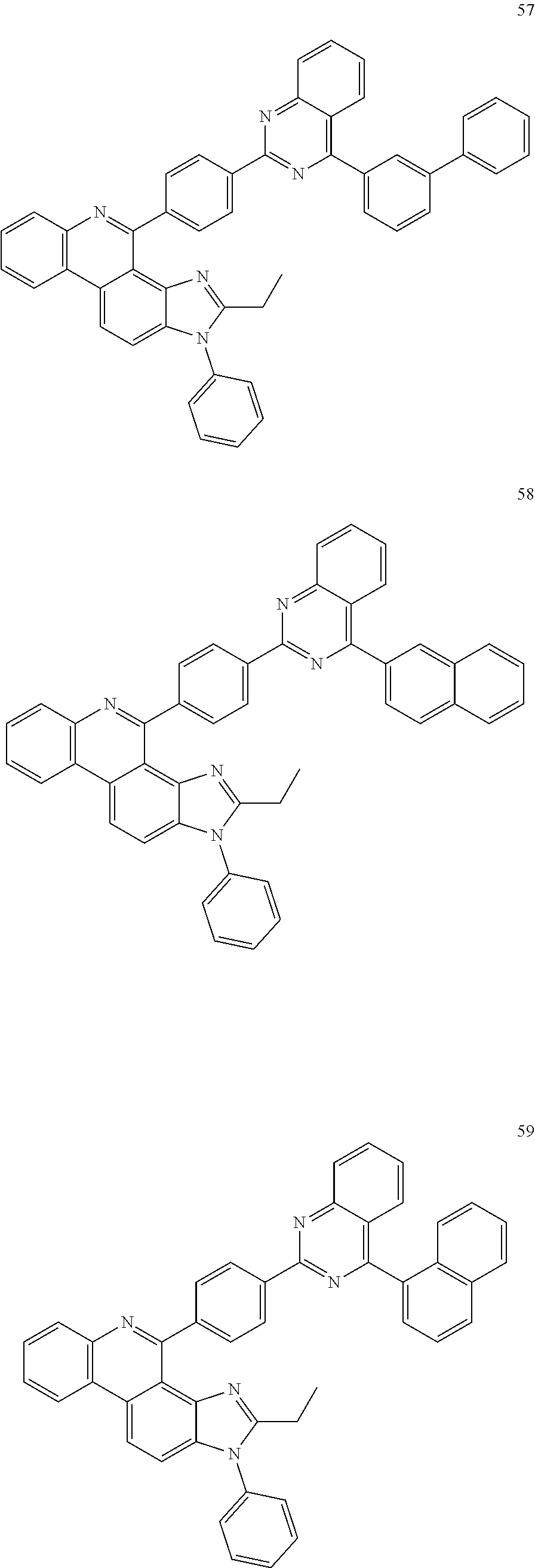

















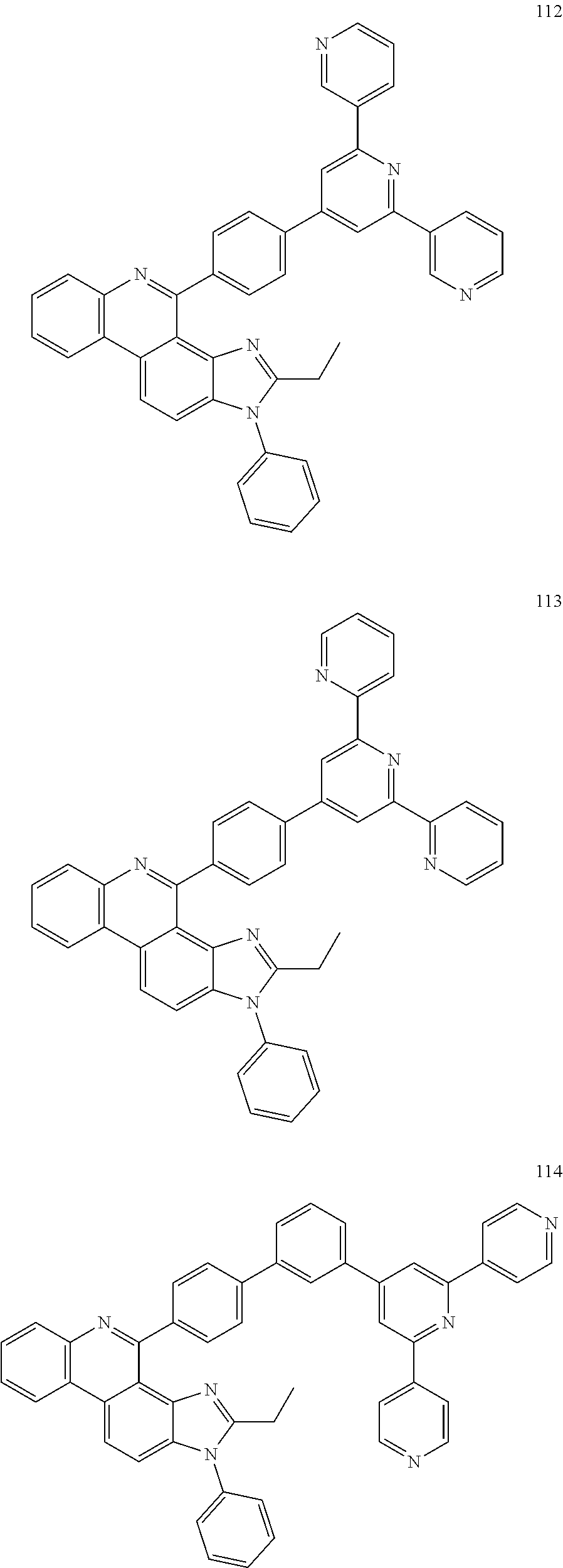


















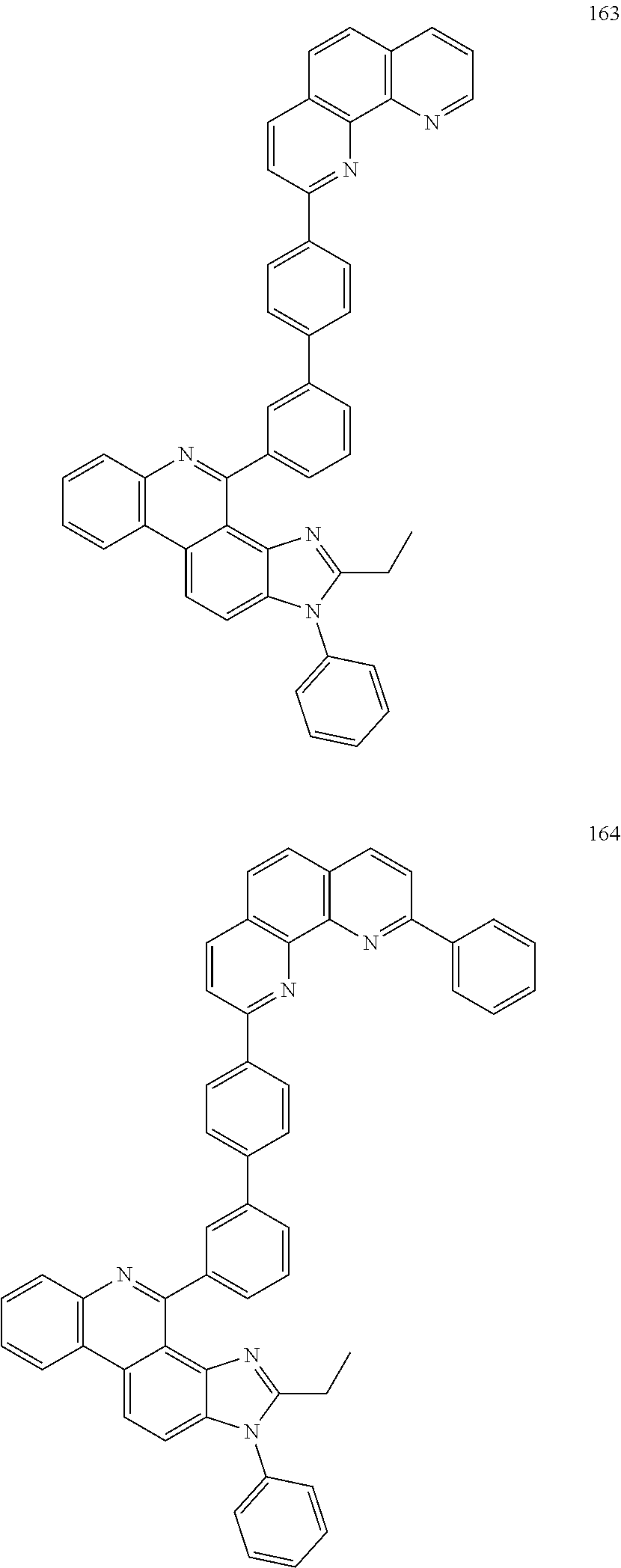


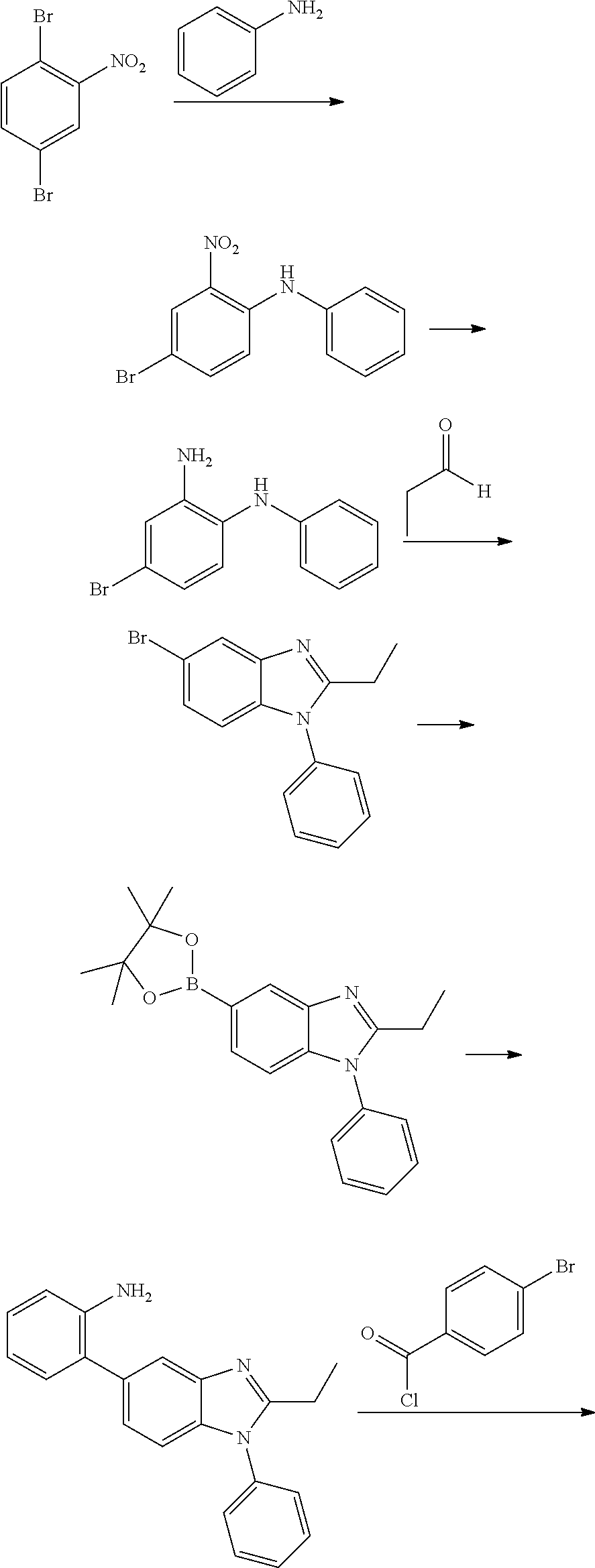













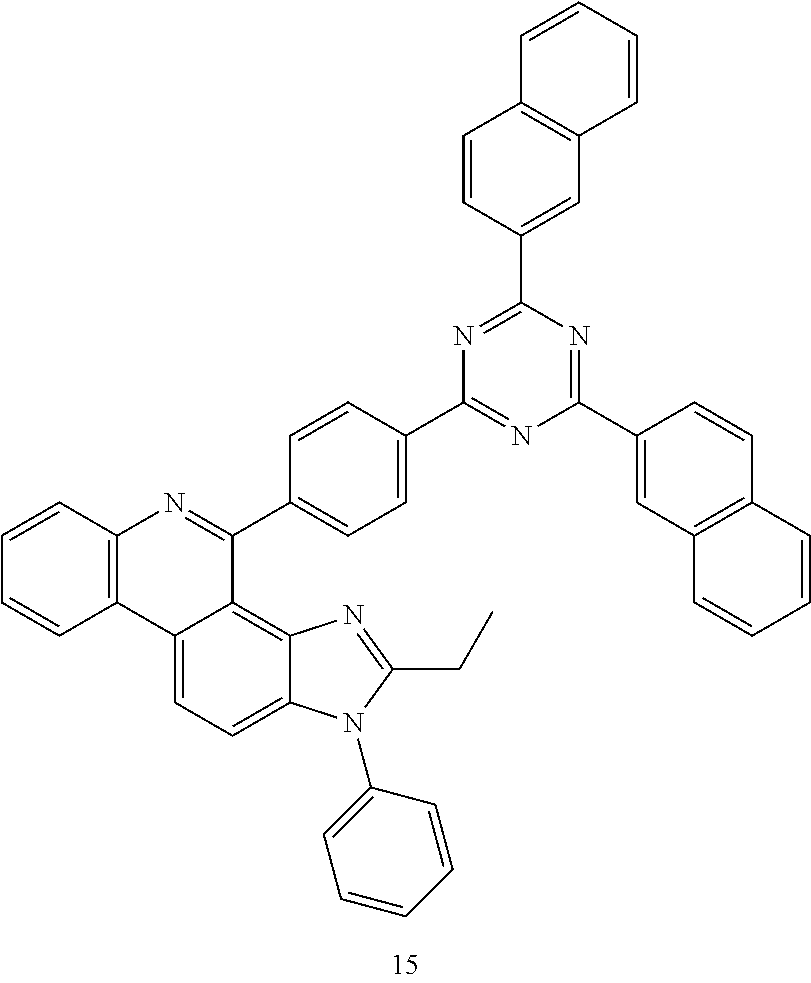



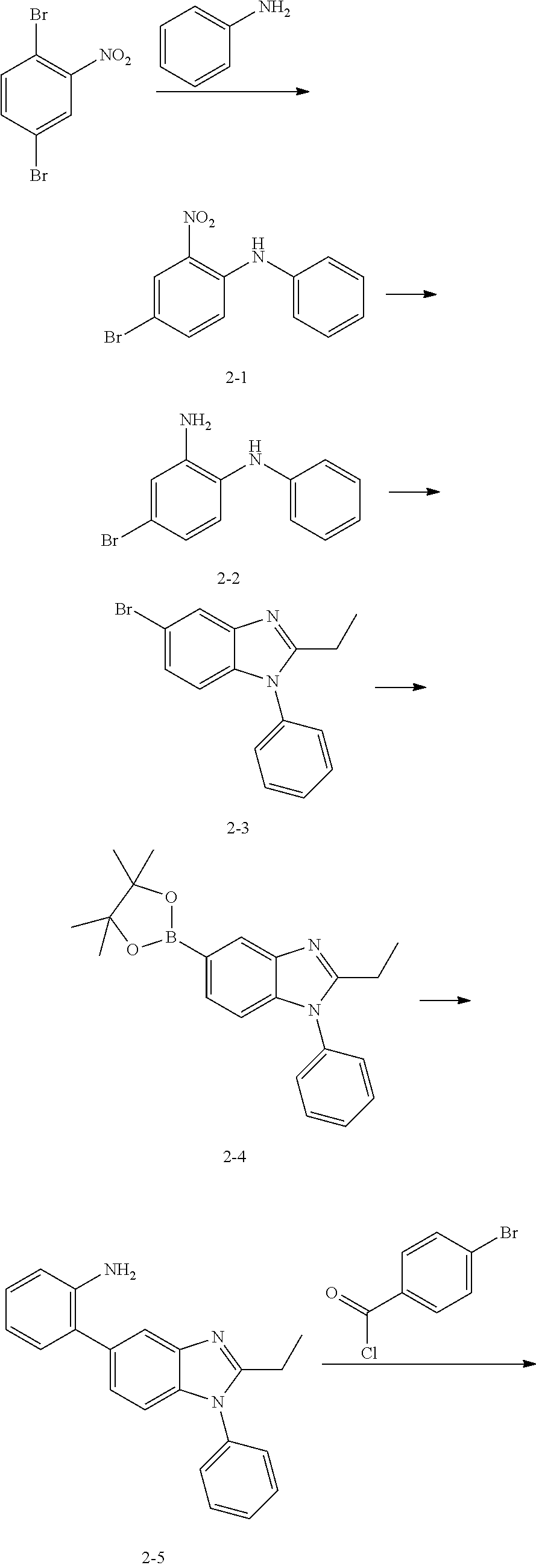
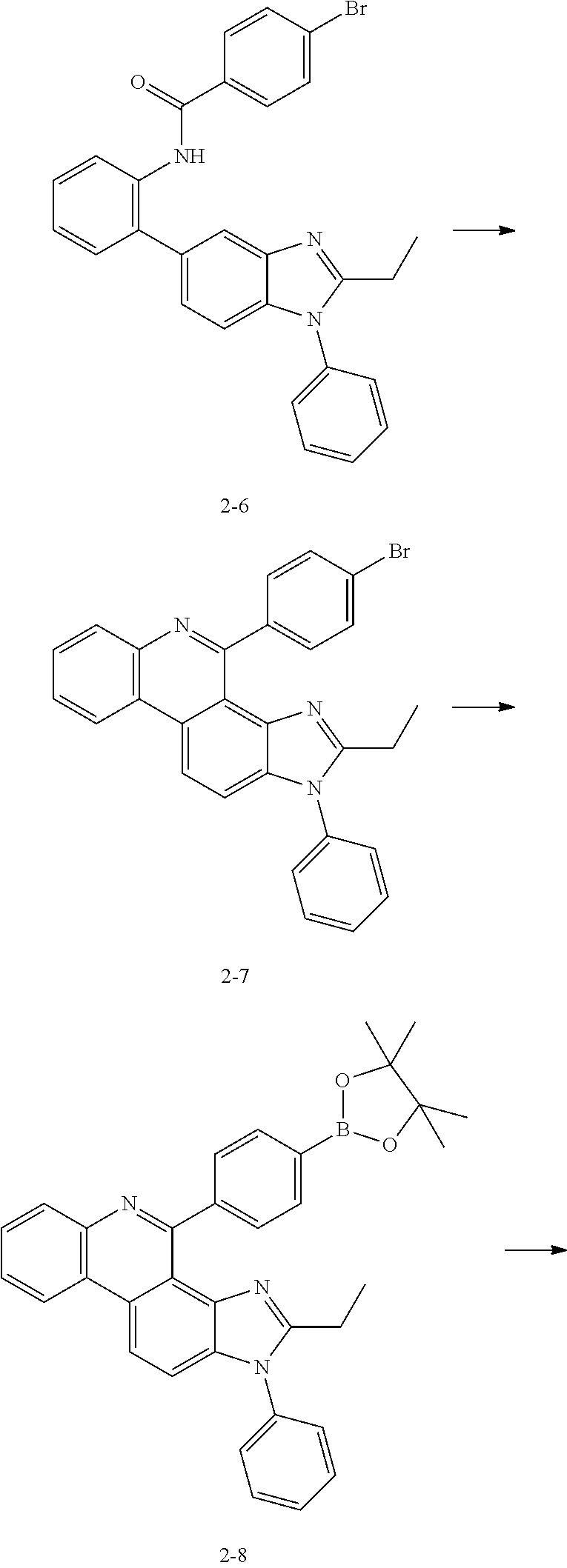
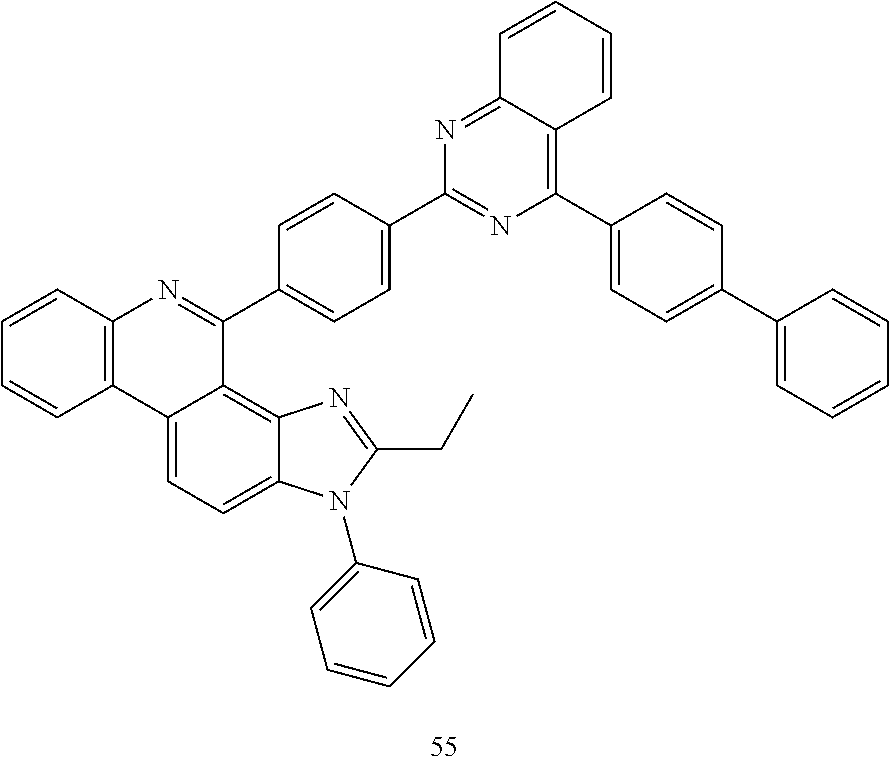







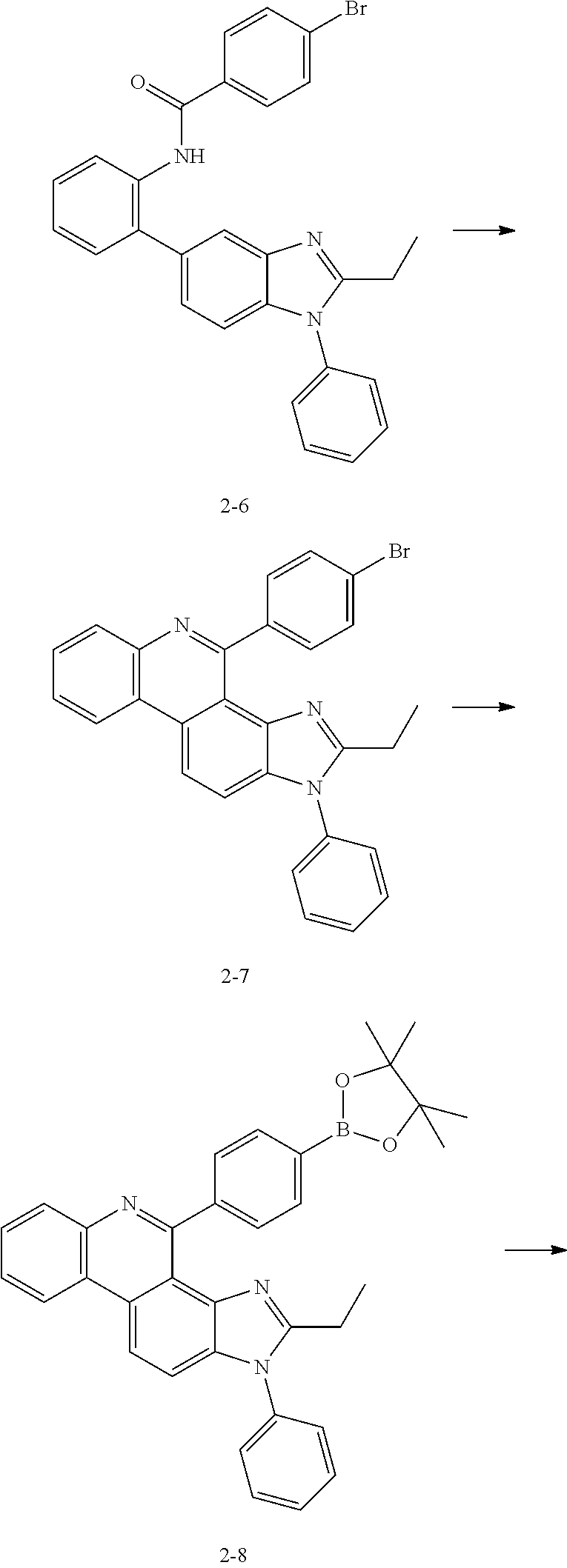




















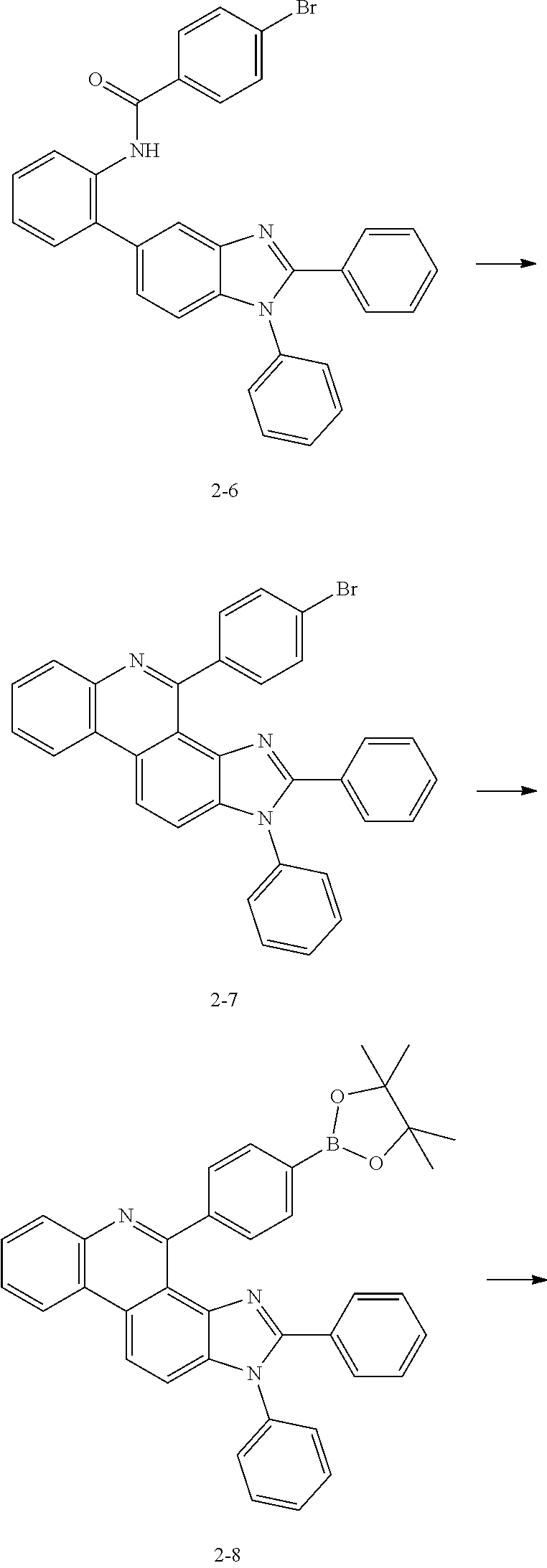


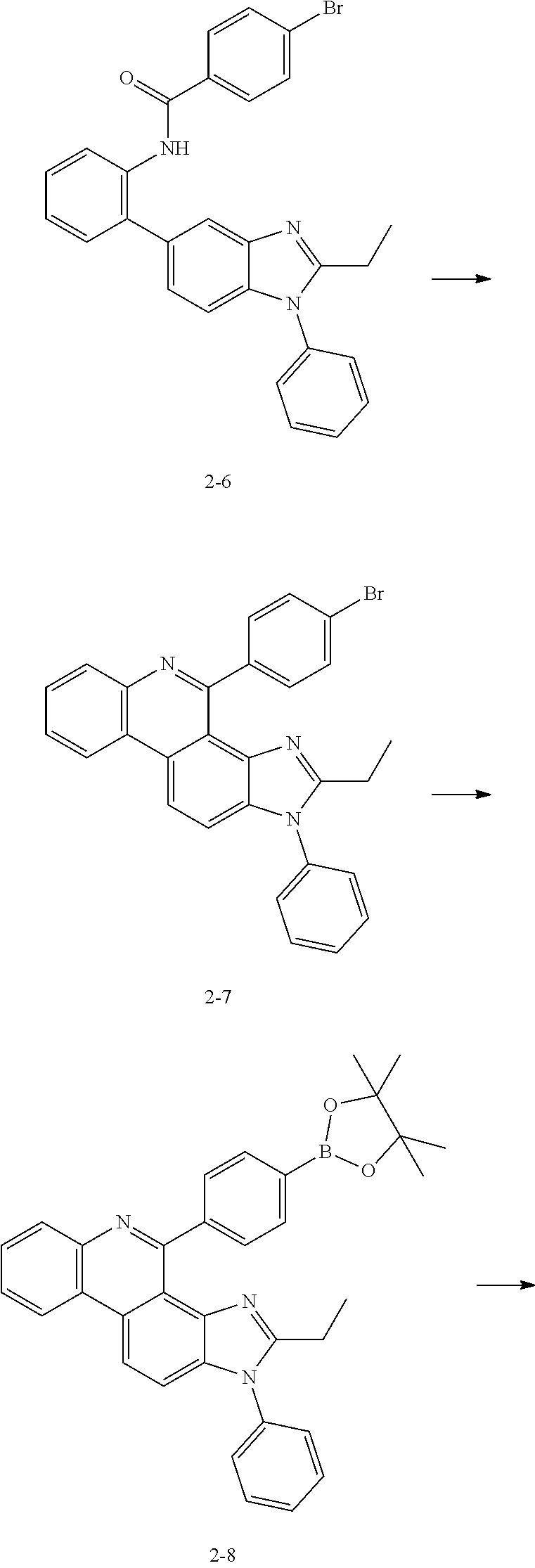



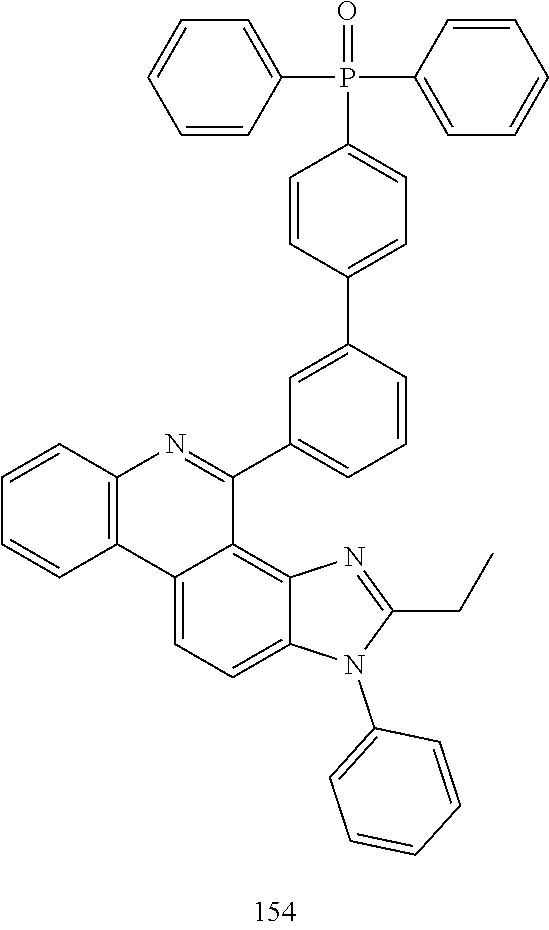











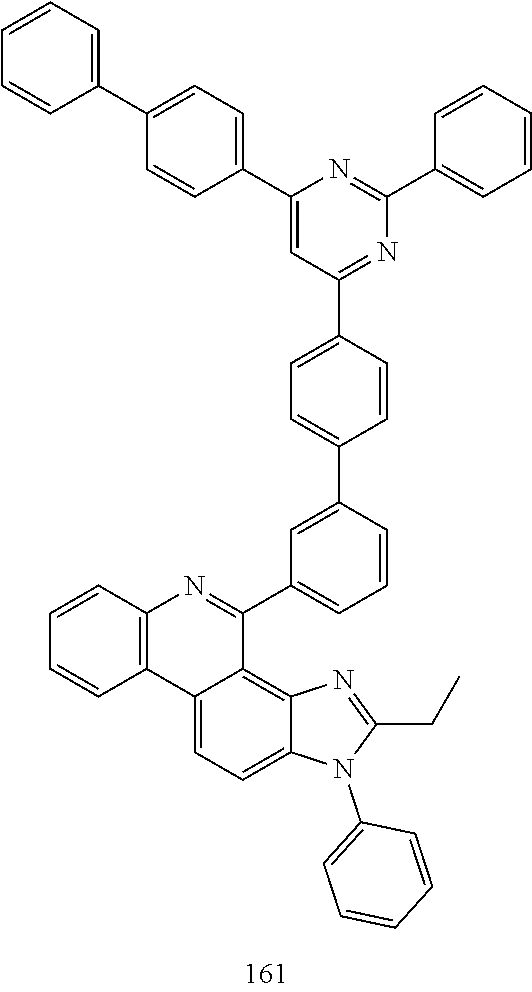


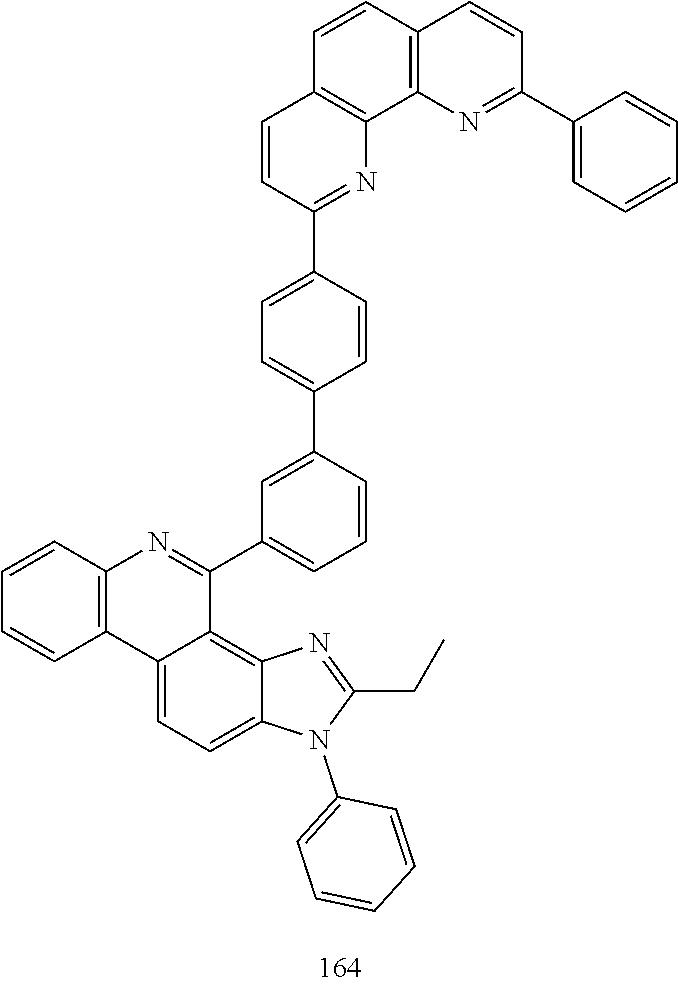



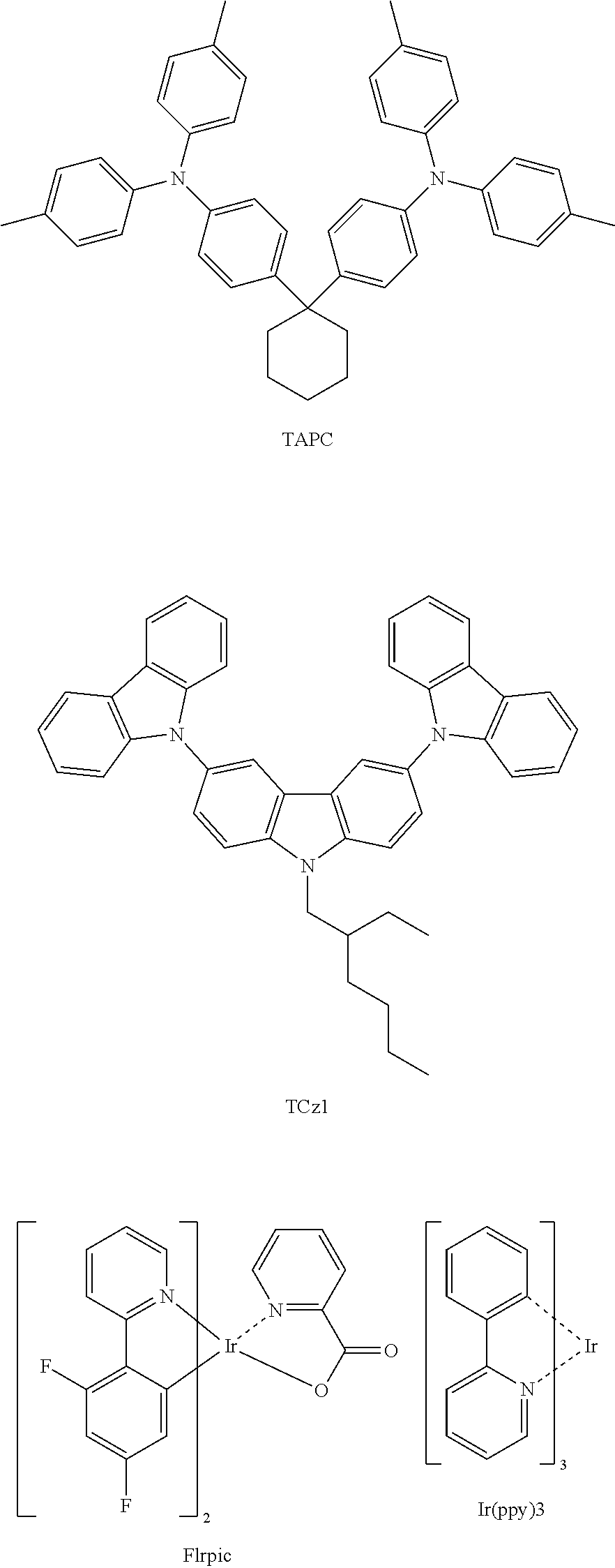





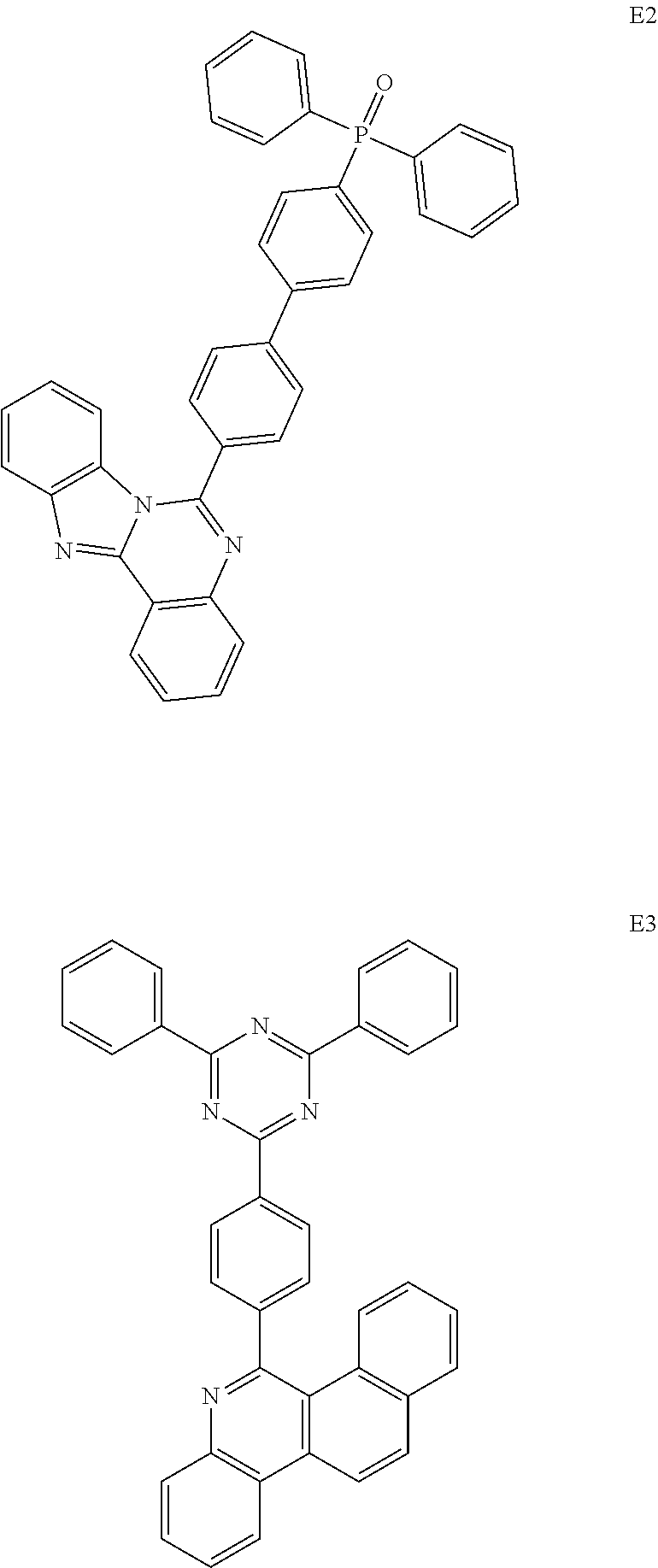



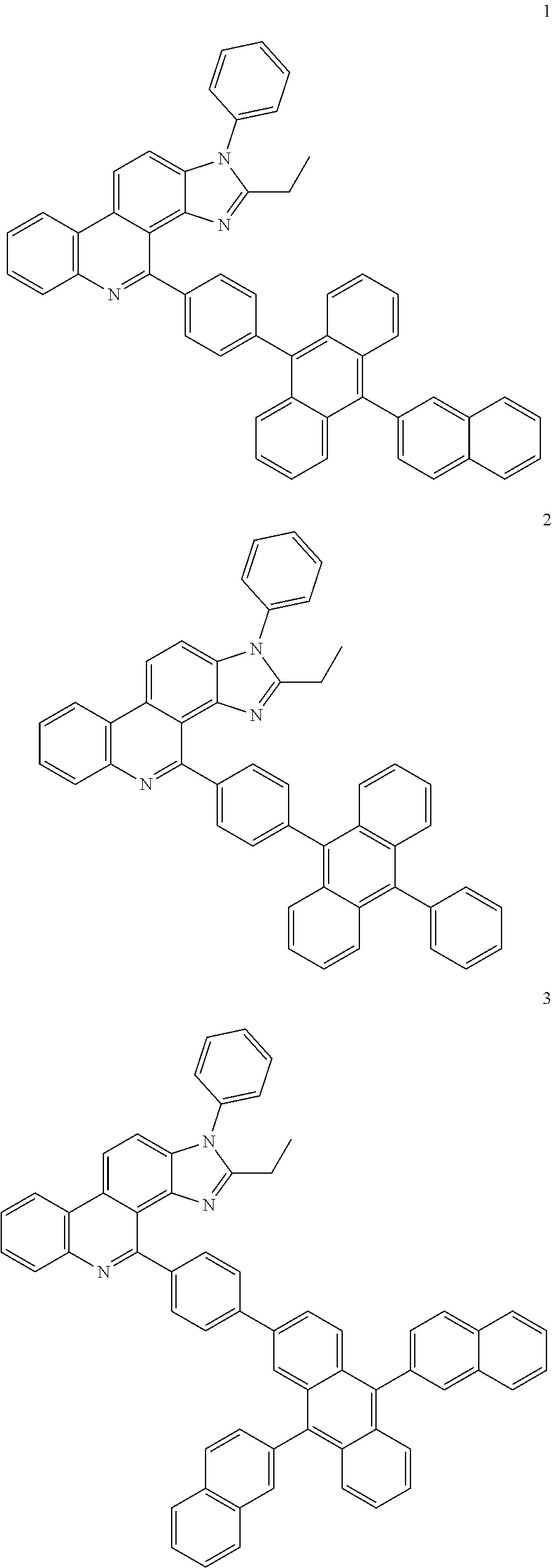



































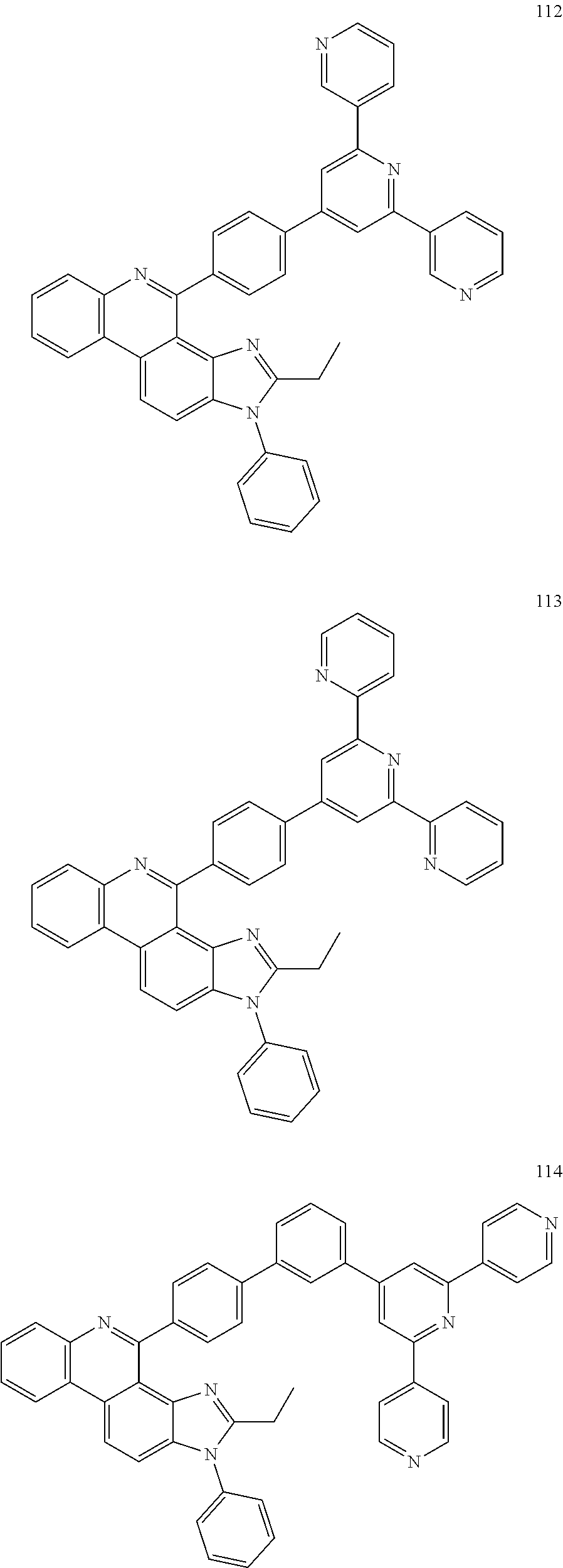


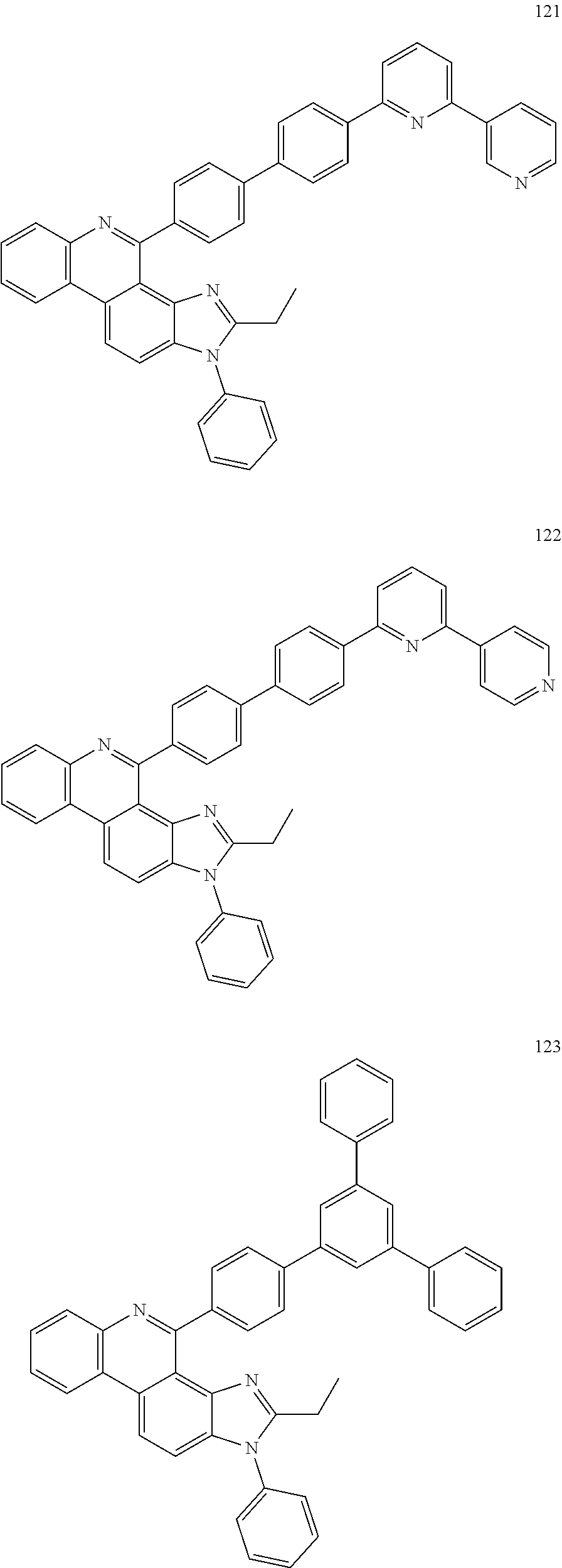








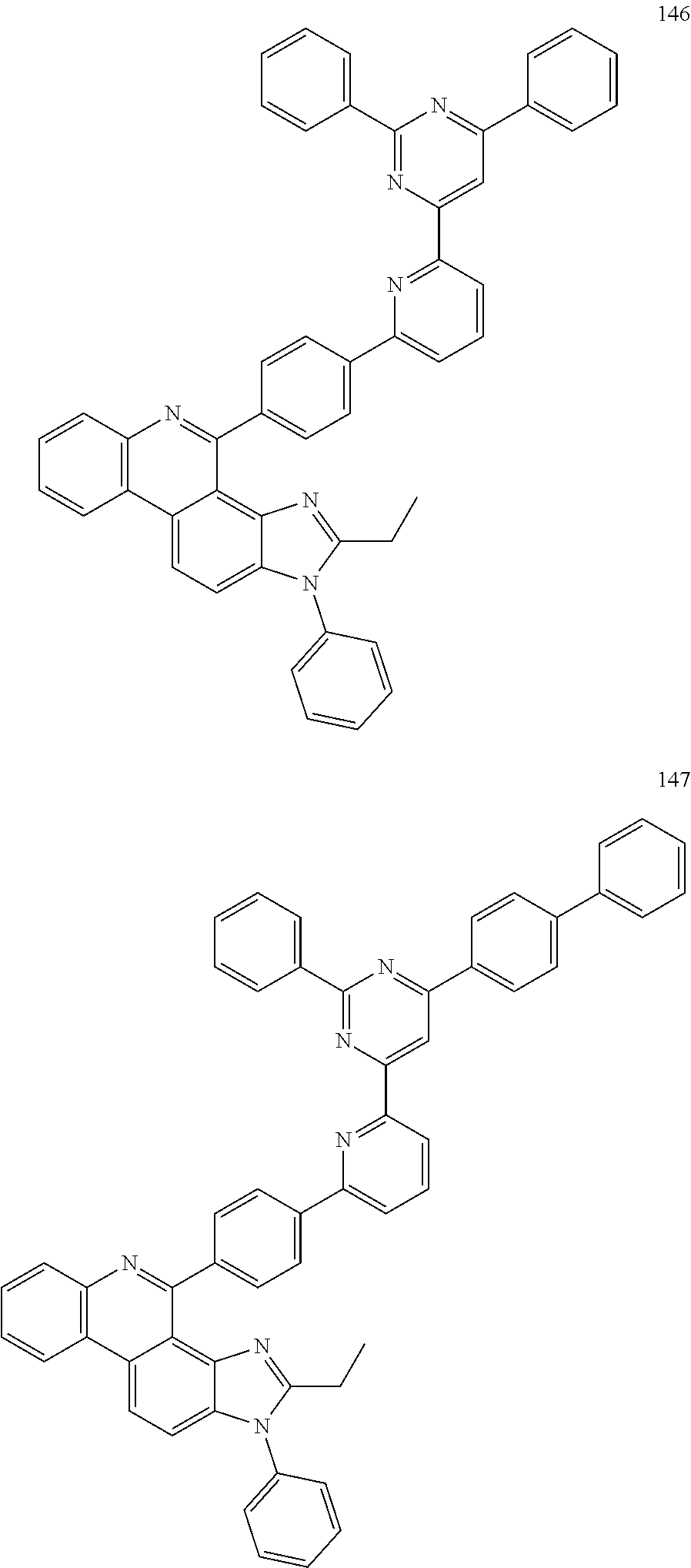





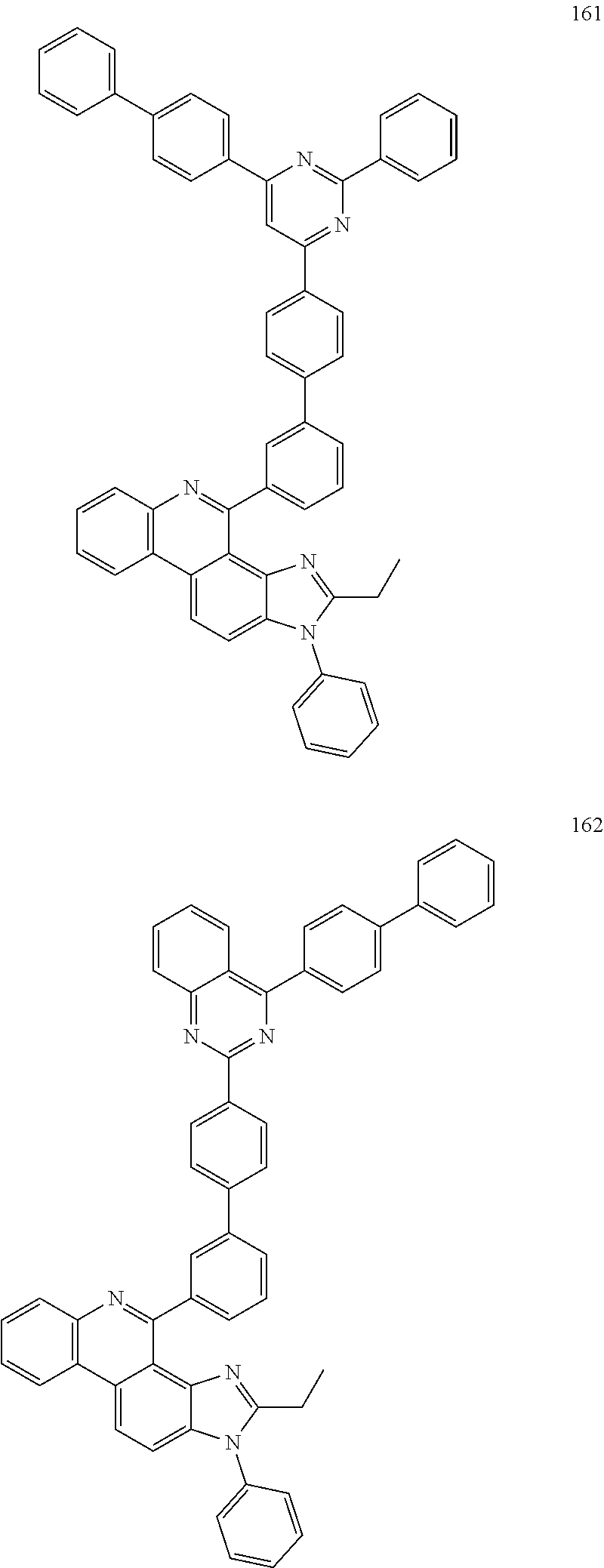



D00000
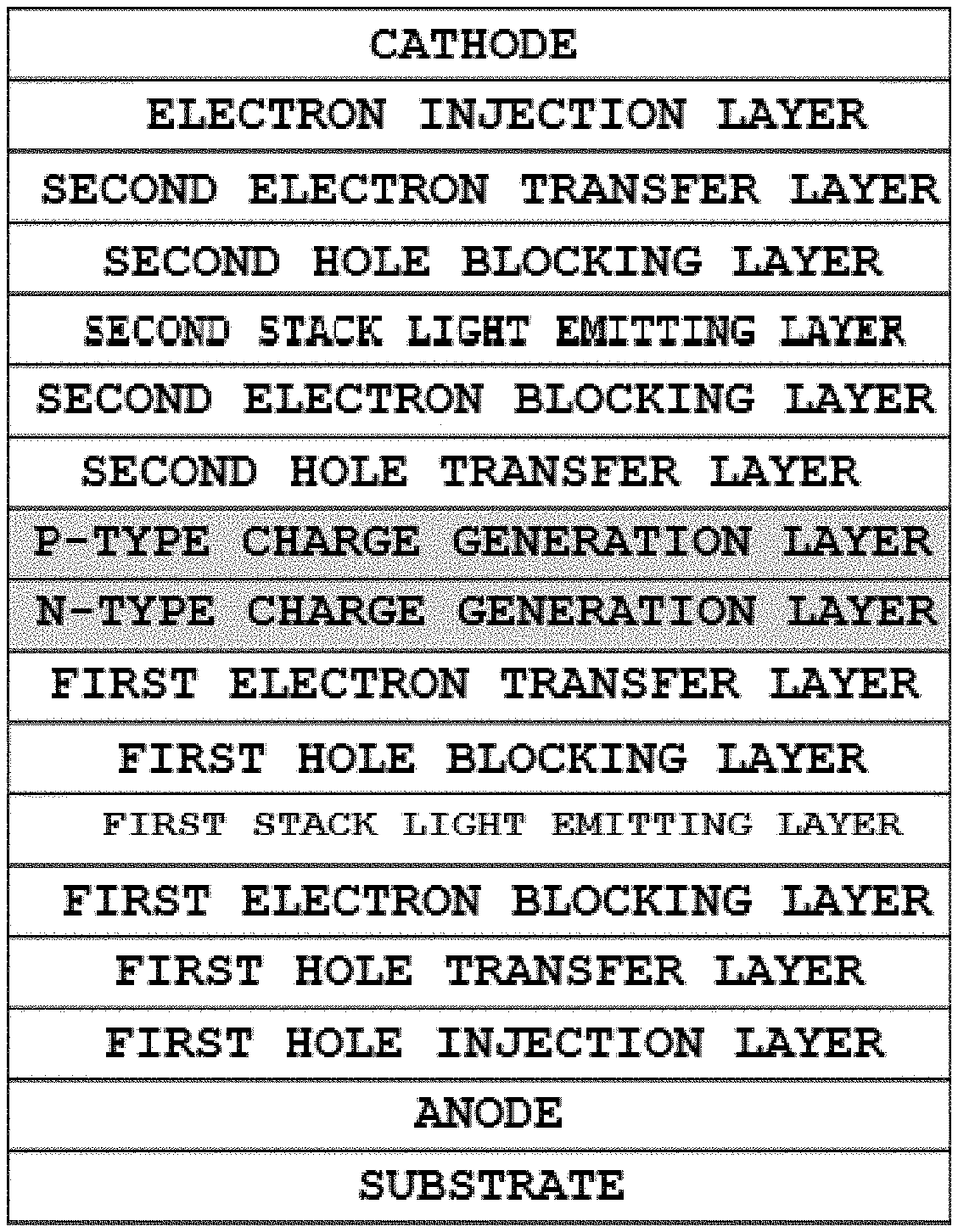
D00001

D00002

D00003
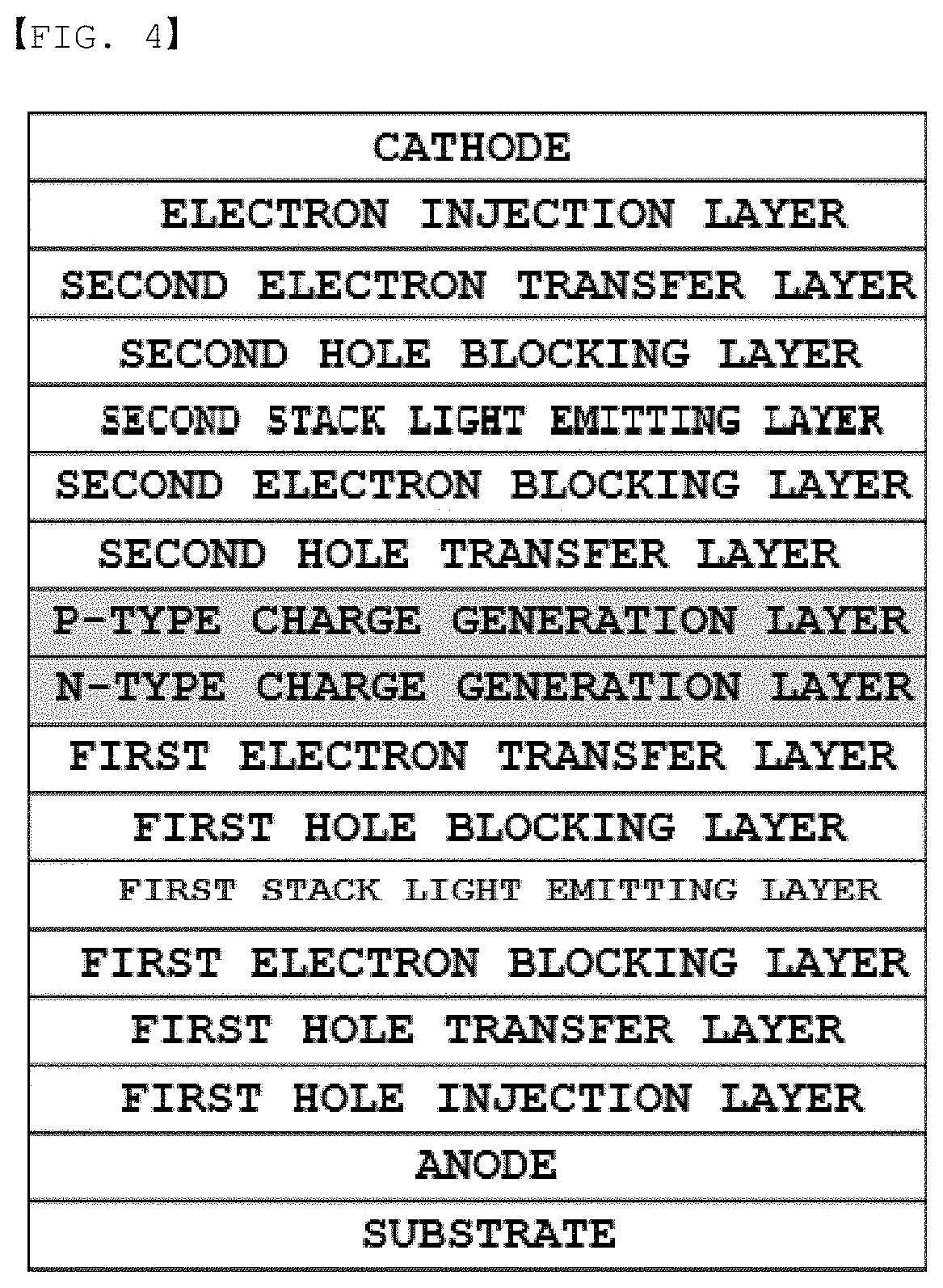
XML
uspto.report is an independent third-party trademark research tool that is not affiliated, endorsed, or sponsored by the United States Patent and Trademark Office (USPTO) or any other governmental organization. The information provided by uspto.report is based on publicly available data at the time of writing and is intended for informational purposes only.
While we strive to provide accurate and up-to-date information, we do not guarantee the accuracy, completeness, reliability, or suitability of the information displayed on this site. The use of this site is at your own risk. Any reliance you place on such information is therefore strictly at your own risk.
All official trademark data, including owner information, should be verified by visiting the official USPTO website at www.uspto.gov. This site is not intended to replace professional legal advice and should not be used as a substitute for consulting with a legal professional who is knowledgeable about trademark law.